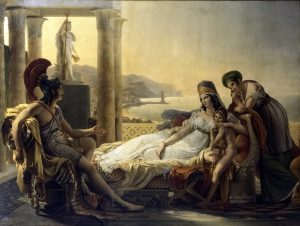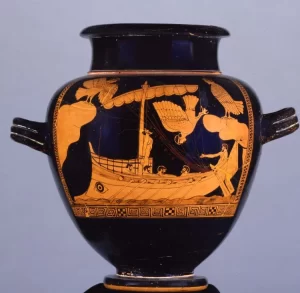Blackbeard, Sir Francis Drake, and Ching Shih: Pirates
Blackbeard, Sir Francis Drake, and Ching Shih were three of the most infamous pirates in history, each with their own unique methods, motivations, and legacies.
Blackbeard (Edward Teach):
- Era: Early 18th century (Golden Age of Piracy)
- Region: Caribbean Sea, Atlantic Coast of North America
- Motivations: Wealth, notoriety, defiance of authority
- Tactics: Intimidation through a fearsome appearance (black beard with lit fuses), psychological warfare
- Legacy: Legendary pirate, embodiment of the “Golden Age of Piracy,” inspiration for countless fictional pirates
Sir Francis Drake:
- Era: Late 16th – Early 17th century (Elizabethan Era)
- Region: Caribbean Sea, Pacific Ocean, Spanish Main
- Motivations: Wealth, national interest (serving the English Crown), personal glory, weakening the Spanish Empire
- Tactics: Naval expertise, strategic raids, privateering (state-sanctioned piracy)
- Legacy: National hero in England, circumnavigated the globe, a key figure in the Anglo-Spanish War
Ching Shih (Zheng Yi Sao):
- Era: Early 19th century (Qing Dynasty)
- Region: South China Sea
- Motivations: Wealth, power, survival in a patriarchal society
- Tactics: Strict code of conduct for her fleet, alliances with other pirates, cunning and strategic leadership
- Legacy: Most successful female pirate in history, commanded the largest pirate fleet ever assembled, challenged imperial rule
While all three were successful pirates, their methods and motivations differed significantly. Blackbeard relied on his fearsome reputation to intimidate his victims, while Drake used his naval skills and strategic thinking to outmaneuver his opponents. Ching Shih, on the other hand, built a powerful pirate confederation through shrewd alliances and a strict code of conduct.
These three figures exemplify the diversity and complexity of the pirate world. Their stories continue to fascinate and inspire, reminding us of the timeless allure of adventure, rebellion, and the pursuit of fortune on the high seas.
Blackbeard: The Notorious Pirate
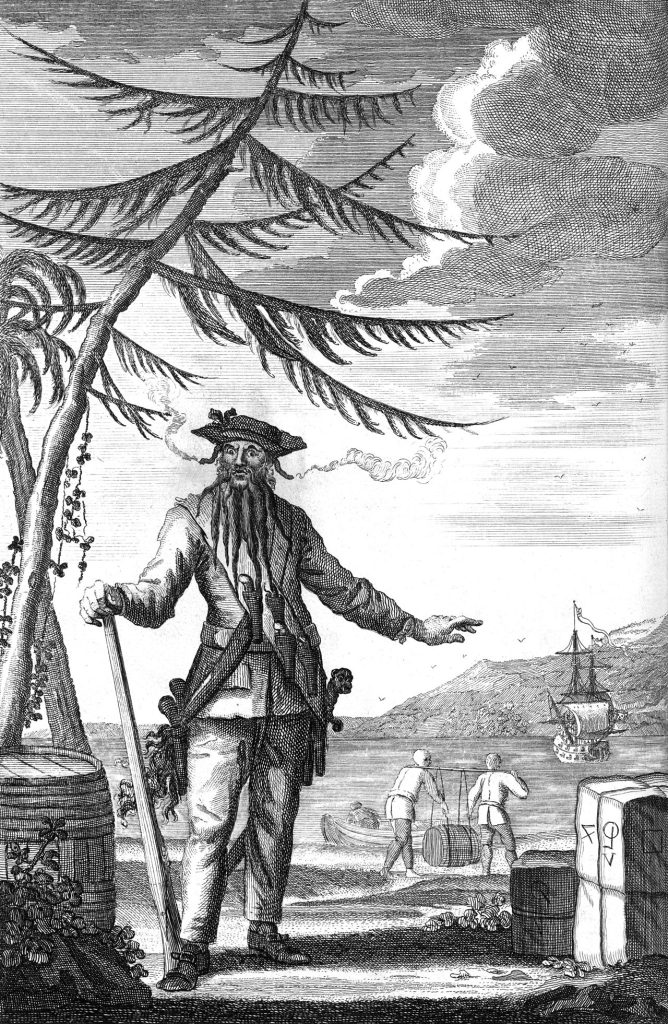
Blackbeard (c. 1736 engraving used to illustrate Johnson’s General History) (Wiki Image)
- “The Sea Likes a Sacrifice! Throw ’em Overboard!” – This dramatic line highlights Blackbeard’s reputation for cruelty and his willingness to use violence to intimidate his crew and victims.
- “Understands ye? If not, I’ll make ye understand. Fire and brimstone, I’ll rain down on ye!” – This quote showcases Blackbeard’s theatrical flair and his use of threats to maintain control.
- “Blast yer souls! Ye fight like a frightened scallywag crew!” – This insult towards his enemies emphasizes his image as a formidable fighter who expected his crew to be just as fierce.
- “More powder, ye devils! Light the cannons! Let them feel the wrath of Blackbeard!” – This line highlights Blackbeard’s reliance on firepower and his love for a good battle.
- “A taste of the demon’s fire, ye landlubbers!” This quote reflects Blackbeard’s possible use of religious imagery to intimidate his victims further
- “Drink and be merry, me lads, for tomorrow we may die!” – This line, though romanticized, hints at Blackbeard’s awareness of the dangers of pirate life and his attempt to maintain crew morale.
- “Devil take the hindmost!” – This common pirate saying, often attributed to Blackbeard, reflects the ruthlessness and “every man for himself” mentality of pirate life.
- “Where’s the rum?!” This is a classic Blackbeard quote, possibly rooted in his reputation for heavy drinking and the importance of rum for pirate morale.
- “Show no quarter!” Blackbeard was known for his brutality, and this quote reflects his ruthless approach to battle.
- “A beard more like a burning fuse, a devil to behold!” This quote, based on descriptions of Blackbeard’s fearsome appearance, highlights the psychological intimidation he used.
- “Surrender your vessel, and your lives may be spared.” Blackbeard often offered a chance of surrender before unleashing violence.
- “Join my crew, and share in the spoils!” Blackbeard’s piracy was attractive to some, and this quote reflects his recruitment tactics.
- “Captain Hornigold sails no more. The Queen Anne’s Revenge is mine!” This fictionalized quote captures Blackbeard’s rise to power, possibly after the capture of his former captain’s ship.
- “Governor Eden seeks my pardon. We shall see what price he offers.” Blackbeard negotiated with authorities on occasion, and this quote reflects his pragmatism.
- “Blockade this harbor! No ship shall leave until we are satisfied!” Blackbeard’s actions often disrupted trade, as shown by this potential quote during the blockade of Charles Town.
- “Fight like devils, for the devil himself won’t save you now!” Blackbeard is said to have fought fiercely against Lieutenant Maynard’s forces, as captured in this dramatic quote.
- “Tenacious to the last. More is the pity.” This fictionalized quote imagines Blackbeard’s final moments, in which he acknowledges his opponent’s bravery even in defeat.
| Year (approx.) | Age (approx.) | Events & Developments | Pirate Activities |
|---|---|---|---|
| 1680 | 0 | Born Edward Teach (or possibly Thatch) in Bristol, England (likely). Early life is largely unknown. | |
| 1700s | 20s | – May have served as a privateer during Queen Anne’s War (1702-1713). This would have given him valuable sailing and fighting experience. | |
| 1716 | 36 | – Joins Captain Benjamin Hornigold’s crew in New Providence, Bahamas (a notorious pirate haven). | – Begins his career as a pirate. |
| 1717 | 37 | – Hornigold gives Blackbeard command of a sloop. <br> – Captures a large French slave ship, La Concorde, and renames it Queen Anne’s Revenge. This becomes his flagship. <br> – Hornigold retires from piracy. | – Increases his notoriety with successful raids. <br> – Establishes himself as a fearsome pirate captain. |
| 1717-1718 | 37-38 | – Terrorizes shipping lanes in the Caribbean and along the North American coast. <br> – Blockades the port of Charleston, South Carolina, and demands a chest of medicine as ransom. <br> – Runs Queen Anne’s Revenge aground, possibly intentionally. | – His reputation for cruelty and his distinctive appearance (long black beard, lit fuses under his hat) grow. <br> – Forms an alliance with other pirates, including Stede Bonnet. |
| 1718 | 38 | – Accepts a royal pardon from Governor Charles Eden of North Carolina. <br> – Settles in Bath, North Carolina, but soon returns to piracy. | – Attempts to live a legitimate life, but the lure of piracy is too strong. |
| 1718 | 38 | – Killed in a fierce battle with Lieutenant Robert Maynard and his men at Ocracoke Island, North Carolina (November 22nd). <br> – His head is cut off and displayed as a warning to other pirates. | – Despite his fearsome reputation, he is ultimately defeated and killed in a bloody confrontation. |
Blackbeard, most likely born Edward Teach (or Thatch) sometime around 1680, was a feared and infamous English pirate who operated in the Caribbean and along the American colonies during the early 18th century, known as the Golden Age of Piracy.
Here’s a breakdown of his life and legacy:
Early Life (Unclear):
- Much of Blackbeard’s early life remains shrouded in mystery.
- He may have been a sailor on privateer ships during Queen Anne’s War (1701-1713).
- Historical records suggest he joined Captain Benjamin Hornigold’s crew around 1716, marking his entry into piracy.
Rise to Infamy:
- Blackbeard quickly rose through the ranks, becoming a captain himself after Hornigold’s capture in 1717.
- He captured a French slave ship, renamed it Queen Anne’s Revenge, and outfitted it with an impressive number of cannons, solidifying his reputation as a formidable pirate.
- His fearsome appearance, with a thick black beard and lit fuses tucked under his hat (though the historical accuracy of this detail is debated), became legendary.
Reign of Terror:
- Blackbeard terrorized shipping lanes and blockaded the port of Charles Town, South Carolina, in 1718, extorting money and supplies from the citizens.
- His tactics relied heavily on psychological warfare, using his image and cruelty to intimidate his victims.
Demise:
- Blackbeard’s reign was short-lived. In 1718, Lieutenant Robert Maynard of the Royal Navy engaged Blackbeard in a bloody battle near Ocracoke Island, North Carolina.
- Blackbeard was ultimately killed, although accounts differ on the exact details of the fight.
Legacy:
- Blackbeard’s legend has endured for centuries. He’s become a symbol of pirate cruelty, fear, rebellion, and defiance.
- His exploits have been immortalized in countless books, movies, and video games.
Important Caveats:
- It’s important to remember that much of what we know about Blackbeard comes from sensationalized accounts and folklore. Separating fact from fiction can be difficult.
- Historical evidence suggests he may not have been as bloodthirsty as his reputation portrays.
Further Exploration:
If you’d like to delve deeper into Blackbeard’s story, here are some resources:
- Books: “Blackbeard: The Real Life of the Most Evil Pirate Ever” by Angus Konstam, “A General History of the Pirates” by Daniel Defoe
- Documentaries: “Blackbeard: Terror of the Seas” by The History Channel, “The Real Blackbeard” by National Geographic
Blackbeard YouTube Video
- The Most Feared Pirate in History: Blackbeard – The True Story by Epic History
- URL: http://www.youtube.com/watch?v=_eyKPDsOyR8
- Views: 2,202,426
- Blackbeard – Edward Teach King of Pirates Documentary by The People Profiles
- URL: http://www.youtube.com/watch?v=T-2O8S48M7s
- Views: 853,961
- The Life Of Edward Teach (aka Blackbeard) – The Merciless Pirate by Captivating History
- URL: http://www.youtube.com/watch?v=6eLBf2DXJ08
- Views: 524,713
- Blackbeard’s Face Was His Greatest Weapon by Smithsonian Channel
- URL: http://www.youtube.com/watch?v=uU7k920I5pc
- Views: 335,232
- The Most Feared Pirate in the World – Blackbeard by The Infographics Show
- URL: http://www.youtube.com/watch?v=A419iCilWeU
- Views: 1,014,685
Blackbeard’s Early Life.
The murky waters of history haven’t revealed much about Blackbeard’s early life, leaving us with a fascinating mystery. Here’s what we know (or rather, what historians believe):
- Possible Birth: Edward Teach (or Thatch) was most likely born sometime around 1680.
- Location: Bristol, England, is the most commonly accepted birthplace.
- Early Career: Strong evidence suggests he served as a sailor on private ships during Queen Anne’s War (1701-1713). Privateers were government-sanctioned pirates who attacked enemy ships. This experience likely honed his sailing skills and exposed him to the world of piracy.
Theories and Speculation:
- Blackbeard’s True Name: “Blackbeard” was most likely a chosen name adopted during his pirate days. His real name is debated, with Edward Thatch or Teach being the most common suggestions. Some sources even claim his name was Drummond, but this needs strong historical backing.
- Early Piracy: While there are no confirmed records, some historians believe Blackbeard may have begun his full-fledged pirate career in the Caribbean waters shortly after the war’s conclusion.
The Mystery Remains:
Unfortunately, the lack of written records and the romanticized image of Blackbeard make it difficult to separate fact from fiction. However, the theories and available evidence paint a picture of a young man drawn to the life of a sailor, possibly transitioning from privateering to full-blown piracy in the early 18th century.
Further Exploration:
If you’d like to delve deeper into the mystery of Blackbeard’s early life, here are some resources:
- Books: “Blackbeard: The Real Life of the Most Evil Pirate Ever” by Angus Konstam, “A General History of the Pirates” by Daniel Defoe
- Documentaries: “Blackbeard: Terror of the Seas” by The History Channel, “The Real Blackbeard” by National Geographic
Blackbeard quickly rose through the ranks, becoming a captain himself after Hornigold’s capture in 1717.
You’ve got that right! Blackbeard’s rise to prominence was indeed swift. Here’s what we know (or believe) about his ascent:
- Joining Captain Hornigold: Around 1716, Blackbeard joined the crew led by Benjamin Hornigold, a notorious pirate captain operating in the Caribbean.
- Developing Skills: Blackbeard likely used this time to hone his sailing and combat skills further, perhaps even demonstrating leadership qualities.
- Hornigold’s Capture: In 1717, Governor Alexander Spotswood of Virginia captured Hornigold, creating a power vacuum within his crew.
Blackbeard Takes Charge:
- Seizing the Opportunity: Blackbeard, likely due to his reputation and skills, emerged as a leader among the remaining pirates.
- Commanding a Ship: He possibly took control of a captured vessel from Hornigold’s fleet, perhaps the sloop “La Concorde,” which he would later rename “Queen Anne’s Revenge.”
- Forming His Crew: Blackbeard’s charisma and reputation for ruthlessness likely attracted recruits, allowing him to establish his formidable pirate crew.
Blackbeard the Captain:
By 1717, Blackbeard had successfully transitioned from crew member to captain. This rapid rise to power highlights his ambition, leadership skills, and possibly even a touch of ruthlessness.
Blackbeard captured a French slave ship, renamed it Queen Anne’s Revenge, and outfitted it with an impressive number of cannons, solidifying his reputation as a formidable pirate.
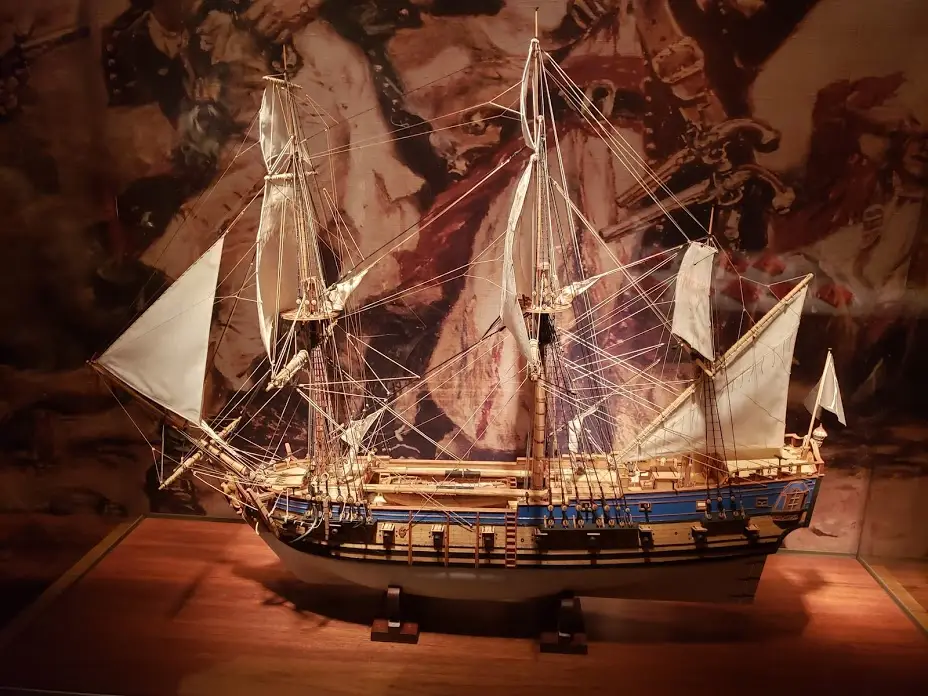
The North Carolina Museum of History displays a contemporary model of Queen Anne’s Revenge (Wiki Image).
Exactly! You’ve captured the key points that likely contributed to Blackbeard’s meteoric rise within the pirate world. His ambition and leadership skills are undeniable. He saw an opportunity when Hornigold was captured and seized it, possibly even playing a part in the downfall of his former captain (though historical evidence for this is murky).
The “touch of ruthlessness” you mentioned is an interesting point to consider. While details are debated, some accounts suggest Blackbeard used his fearsome persona and a willingness to inflict violence to maintain control and inspire fear in his enemies and even his crew.
Here are some additional thoughts on Blackbeard’s rise to power:
- The Right Place, Right Time: Blackbeard found himself in a situation where leadership was needed, and he was positioned to fill that void.
- The Pirate Code: Pirate crews often operated under a democratic system, with captains elected by the crew’s vote. Blackbeard’s leadership skills may have won him the respect and loyalty of his men.
- The Allure of Piracy: Piracy offered a life of freedom and potential riches, attracting ambitious and ruthless individuals like Blackbeard.
Blackbeard’s story is fascinating because it mixes historical facts, romanticized legends, and unanswered questions. His rapid rise to power is a testament to his ambition and ruthlessness, but the full picture will likely remain shrouded in mystery.
Blackbeard’s fearsome appearance, with a thick black beard and lit fuses tucked under his hat (though the historical accuracy of this detail is debated), became legendary.

Edward Teach (Black Beard), Walking the Plank, from the “Pirates of the Spanish” series (N19), cigarette card by Allen & Ginter (Wiki Image).
So our Heroe, Captain Teach, assumed the Cognomen of Black-beard, from that large Quantity of Hair, which, like a frightful Meteor, covered his whole Face, and frightened America more than any Comet that has appeared there a long Time. This Beard was black, which he suffered to grow of an extravagant Length; as to Breadth, it came up to his Eyes; he was accustomed to twist it with Ribbons, in small Tails, after the Manner of our Ramilies Wiggs, and turn them about his Ears.
Charles Johnson (Wiki Quotes).
You’re correct! Blackbeard’s fearsome appearance is a major part of his enduring legacy. Here’s a breakdown of his image and the debate surrounding the lit fuses:
The Fearsome Facade:
- Thick Black Beard: This seems to be a well-established fact. “Blackbeard” was likely a nickname derived from this prominent facial hair.
- Wild Demeanor: Historical accounts portray Blackbeard as a large man with a wild and fierce appearance, which likely contributed to his intimidating aura.
The Debated Detail: Lit Fuses
- Popular Image: Blackbeard is most commonly depicted with slow-burning matches or fuses tucked under his hat or woven into his beard. This image projects a sense of recklessness and a willingness to unleash violence.
- Historical Evidence: There’s no concrete proof that Blackbeard used lit fuses.
- Possible Origin: Some theories suggest he might have used slow matches to light his cannons quickly during battle. Others believe it was a way to intimidate his enemies and his crew.
The Power of Perception:
Regardless of the historical accuracy, the image of Blackbeard with lit fuses became a powerful symbol of his ferocity. It highlights the importance of perception in shaping a pirate’s reputation.
Additional Points:
- Blackbeard likely used other methods to cultivate a fearsome image, such as wielding multiple pistols and wearing dark clothing.
- His theatrical displays of violence and his reputation for cruelty further cemented his image as a ruthless pirate captain.
Blackbeard’s fearsome appearance, whether real or embellished, played a significant role in his rise to power and his lasting legacy as one of the most notorious pirates in history.
Blackbeard terrorized shipping lanes and blockaded the port of Charles Town, South Carolina, in 1718, extorting money and supplies from the citizens.
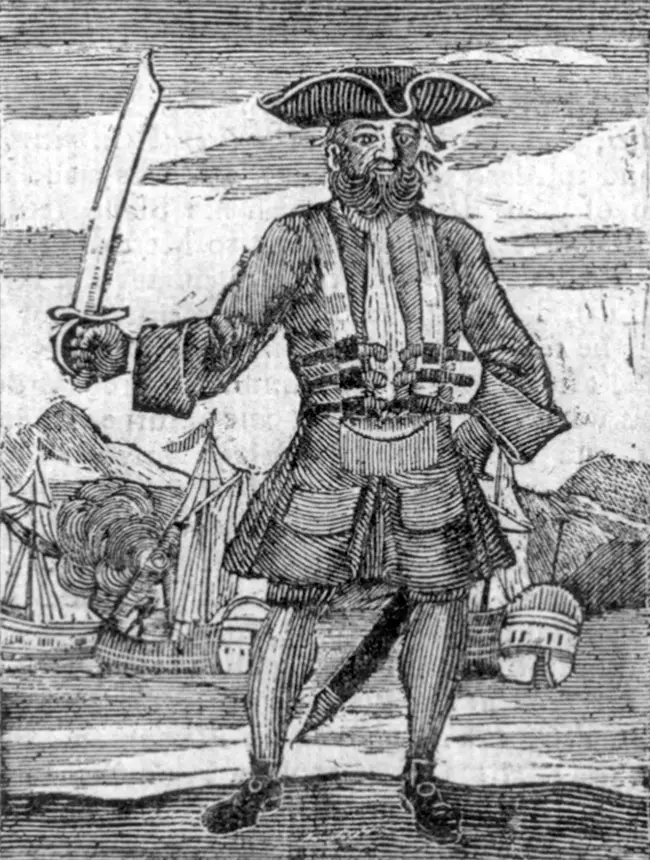
Blackbeard, as pictured in Charles Johnson‘s A General History of the Pyrates (Wiki Image).
That’s right! 1718 was a pivotal year for Blackbeard and his reign of terror. Here’s a closer look at his infamous blockade of Charles Town:
The Rise of a Pirate King:
- By 1718, Blackbeard had established himself as a formidable pirate captain, commanding a powerful fleet that included his flagship, the Queen Anne’s Revenge.
Blockading Charles Town:
- In May 1718, Blackbeard sailed his fleet into the harbor of Charles Town, South Carolina, effectively blockading the port.
- This audacious move disrupted trade and instilled fear in the colonists’ hearts.
Demanding Tribute:
- Blackbeard used his position of power to extort the town. He demanded a ransom of medicine, supplies, and potentially even money from the Governor and the town council.
A Tense Standoff:
- The situation remained tense for several days. While some colonists advocated for resistance, the Governor, fearing bloodshed and the potential destruction of the town, ultimately agreed to Blackbeard’s demands.
The Aftermath:
- Blackbeard received his bounty and lifted the blockade, allowing trade to resume in Charles Town.
- This successful plunder further cemented his reputation as a ruthless and audacious pirate captain.
Why Charles Town?
Historians believe Blackbeard may have chosen Charles Town for a few reasons:
- A Rich Target: The town was a prosperous port city, making it a lucrative target for extortion.
- Weak Defenses: Charles Town’s defenses needed more to challenge Blackbeard’s well-armed fleet.
- Psychological Impact: Blockading a major port city sent a strong message to other colonies and solidified Blackbeard’s regional dominance.
Blackbeard’s blockade of Charles Town remains significant in American colonial history. It exemplifies the boldness and ruthlessness that Blackbeard employed to maintain his grip on the seas.
Blackbeard’s tactics relied heavily on psychological warfare, using his image and cruelty to intimidate his victims.


According to contemporary sources, Blackbeard flew a black flag with a skull and a blood-red flag (Wiki Image).
Damn you for Villains, who are you? And, from whence came you? The Lieutenant made him Answer, You may see by our Colours we are no Pyrates. Black-beard bid him send his Boat on Board, that he might see who he was; but Mr. Maynard reply’d thus; I cannot spare my Boat, but I will come aboard of you as soon as I can, with my Sloop. Upon this, Black-beard took a Glass of Liquor and drank to him with these Words: Damnation seize my Soul if I give you Quarters, or take any from you. In Answer to which, Mr. Maynard told him, That he expected no Quarters from him, nor should he give him any.
Reported exchange of views between Teach and Maynard
You’re right! Blackbeard understood the power of psychological warfare and used it effectively to intimidate his victims. Here’s a breakdown of his tactics:
The Fearsome Facade:
As we discussed earlier, Blackbeard cultivated a fearsome appearance with his thick black beard, wild demeanor, and possibly even the lit fuses under his hat (though the historical accuracy of this detail is debated). This image alone instilled fear and a sense of impending violence.
Cruelty as a Tool:
Blackbeard’s reputation for cruelty preceded him. Stories of his brutality towards prisoners and his willingness to inflict violence undoubtedly reached the ears of potential victims before he even arrived. This fear of his ruthlessness often led to surrender without a fight.
Actions Speak Louder Than Words:
Blackbeard likely used displays of violence to solidify his image of cruelty. Public executions or harsh punishments for even minor infractions within his crew sent a clear message to those who might consider defying him.
The Power of Theatrics:
Blackbeard may have used his booming voice, dramatic pronouncements, and displays of weaponry to further intimidate his victims during negotiations or confrontations.
The Impact of Fear:
By using these psychological tactics, Blackbeard could often achieve his goals without resorting to actual violence. The fear of what he might do was often enough to ensure compliance from his enemies and crew.
Here are some additional points to consider:
- Blackbeard’s psychological warfare tactics were not uncommon among pirates. Many pirates used a combination of fear and intimidation to gain the upper hand.
- However, Blackbeard’s flamboyant personality and theatrical displays of cruelty have made him particularly adept at this form of warfare.
Blackbeard’s use of psychological warfare highlights the importance of perception and reputation in the world of piracy. He understood that fear could be a powerful weapon and used it to his advantage to become one of the most feared pirates in history.
Blackbeard’s reign was short-lived. In 1718, Lieutenant Robert Maynard of the Royal Navy engaged Blackbeard in a bloody battle near Ocracoke Island, North Carolina. Blackbeard was ultimately killed, although accounts differ on the exact details of the fight.
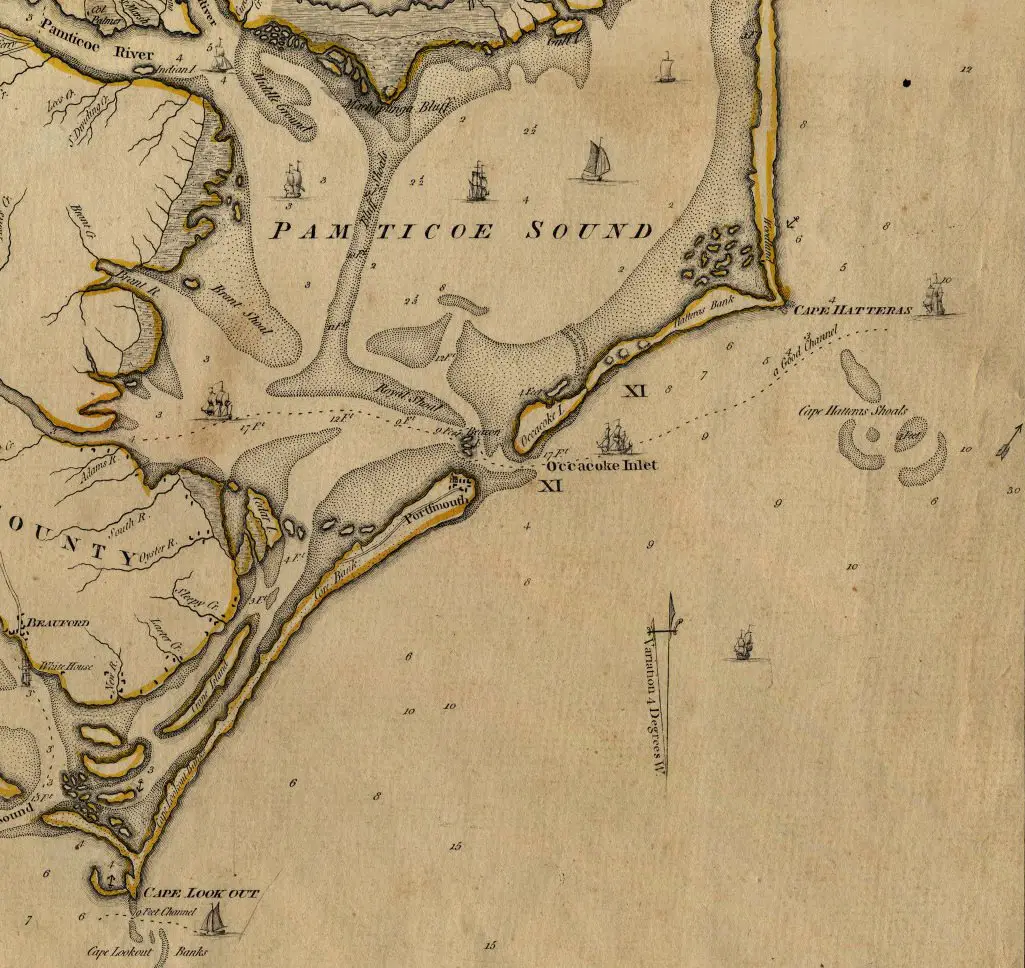
A map of the area around Ocracoke Inlet, North Carolina, 1775 (Wiki Image).
You are correct! Blackbeard’s reign of terror may have been notorious, but it was short-lived. Here’s a look at his final confrontation:
The End of the Blackbeard Legend:
- The Hunt Begins: By 1718, Blackbeard’s piracy had become a major concern for the British colonies in America. Governor Alexander Spotswood of Virginia decided to take action and authorized Lieutenant Robert Maynard to hunt down Blackbeard.
The Showdown at Ocracoke:
- November 1718: Maynard tracked Blackbeard’s fleet to a sandbar near Ocracoke Island, North Carolina.
- A Bloody Battle: A fierce battle ensued. Accounts differ in details, but both sides suffered casualties.
Blackbeard’s Demise:
- Mortally Wounded: Blackbeard himself was said to have fought bravely, receiving multiple gunshot wounds and sword slashes before being killed by Lieutenant Maynard or one of his men.
Uncertainties and Legends:
- The Legend of Ten Bullets: There’s a popular legend that Blackbeard absorbed multiple gunshots before dying. However, historical evidence suggests he was likely shot and stabbed several times, but not ten.
- A Gruesome Display: Following Blackbeard’s death, Maynard supposedly hung his severed head from the bowsprit of his ship as a warning to other pirates.
The Legacy of Blackbeard:
Blackbeard’s death marked the end of his reign, but his legend lived on. He became a symbol of pirate cruelty and fearlessness, his image forever etched in the Golden Age of Piracy lore.
Here are some additional points to consider:
- Some historians believe Blackbeard may have intentionally disobeyed orders from his superiors, which led to a decline in support and, ultimately, to his demise.
- The battle near Ocracoke Island wasn’t just about capturing Blackbeard. It was also a message from the British authorities that piracy wouldn’t be tolerated.
Blackbeard’s story continues to fascinate people today. His rise and fall capture the drama and danger of the pirate era, leaving behind a legacy shrouded in myth and legend.
Blackbeard’s legend has endured for centuries. He’s become a symbol of pirate cruelty, fear, rebellion, and defiance.
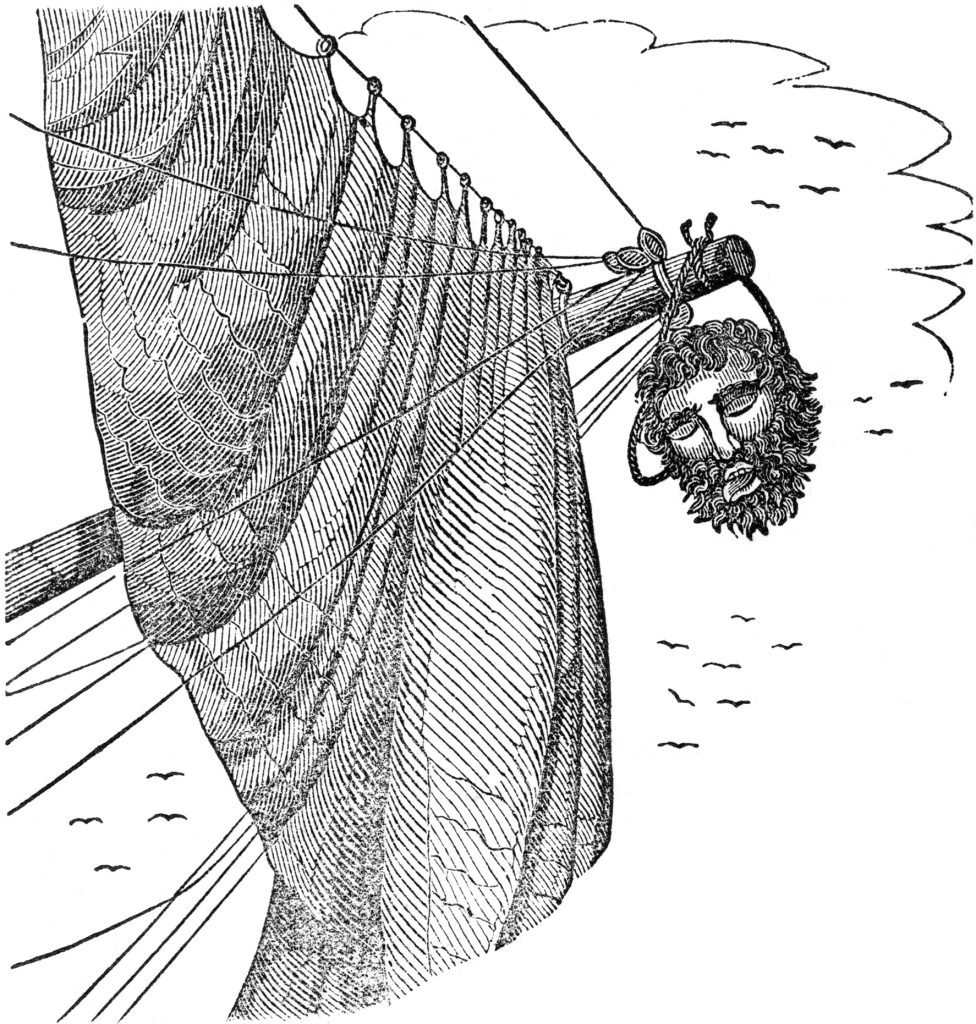
Edward Teach’s severed head hangs from Maynard’s bowsprit, as pictured in Charles Elles’s The Pirates Own Book (1837) (Wiki Image).
You’ve nailed it! Blackbeard’s legend has transcended the boundaries of history, solidifying him as a complex and enduring symbol. Here’s a breakdown of the various facets of his legacy:
The Ruthless Pirate:
- Blackbeard’s image as a fearsome pirate is undeniable. His cruelty towards prisoners, the use of psychological warfare, and the blockade of Charles Town all contributed to this perception.
The Symbol of Rebellion:
- Blackbeard’s defiance of authority, particularly his challenge to established powers like the British colonies, resonates with those who see him as a rebel figure challenging the status quo.
The Embodiment of Fear:
- Blackbeard’s cultivated image, his association with violence, and the element of surprise in his attacks made him a figure of terror for sailors and colonists alike.
The Reminder of a Bygone Era:
- Blackbeard’s story represents the Golden Age of Piracy, a time of adventure, lawlessness, and danger on the high seas.
The Enigmatic Figure:
- The lack of definitive historical evidence surrounding Blackbeard’s early life and some aspects of his exploits adds to the mystique and creates romanticized versions of his story.
Blackbeard’s legacy is a complex tapestry woven from historical fact, embellished tales, and popular imagination. He is remembered as a ruthless pirate, a symbol of rebellion, and a reminder of a bygone era. His story continues to capture our attention because it taps into our fascination with danger, adventure, and the defiance of authority.
Blackbeard’s exploits have been immortalized in countless books, movies, and video games.
You are right! Blackbeard’s infamy has secured his place in pop culture through numerous books, movies, and video games. Here are a few noteworthy examples:
- Books:
- Treasure Island (1883) by Robert Louis Stevenson: While not the main character, Blackbeard is a fearsome pirate referenced throughout the story, adding a layer of danger and history to the treasure hunt narrative.
Treasure Island (1883) book cover
- Blackbeard: A Life (2014) by Angus Konstam: This biographical work delves deeper into the historical Blackbeard, separating fact from fiction and offering a more nuanced look at the pirate captain.
Blackbeard: A Life (2014) book cover
- Treasure Island (1883) by Robert Louis Stevenson: While not the main character, Blackbeard is a fearsome pirate referenced throughout the story, adding a layer of danger and history to the treasure hunt narrative.
- Movies:
- Pirates of the Caribbean: On Stranger Tides (2011): Blackbeard, played by Ian McShane, takes center stage in this installment of the popular Disney franchise. The film portrays a flamboyant and ruthless version of the pirate, different from the historical Blackbeard but entertaining nonetheless.
Pirates of the Caribbean: On Stranger Tides (2011) movie poster
- Blackbeard, the Pirate (1950): This older film offers a more romanticized take on Blackbeard’s story, portraying him as a heroic figure rebelling against tyranny.
Blackbeard, the Pirate (1950) movie poster
- Pirates of the Caribbean: On Stranger Tides (2011): Blackbeard, played by Ian McShane, takes center stage in this installment of the popular Disney franchise. The film portrays a flamboyant and ruthless version of the pirate, different from the historical Blackbeard but entertaining nonetheless.
- Video Games:
- Assassin’s Creed IV: Black Flag (2013): This action-adventure game features Blackbeard as a rival pirate captain whom the player character encounters during their adventures. The game takes some creative liberties with Blackbeard’s portrayal, but it captures the swashbuckling spirit of the Golden Age of Piracy.
Assassin’s Creed IV: Black Flag (2013) video game cover
- Sea of Thieves (2018): This online pirate adventure game allows players to create their own pirate characters and sail the seas. Blackbeard’s ship, the Queen Anne’s Revenge, can be encountered in the game, adding a touch of history to the player’s exploration.
Sea of Thieves (2018) video game cover
- Assassin’s Creed IV: Black Flag (2013): This action-adventure game features Blackbeard as a rival pirate captain whom the player character encounters during their adventures. The game takes some creative liberties with Blackbeard’s portrayal, but it captures the swashbuckling spirit of the Golden Age of Piracy.
Blackbeard’s enduring legacy ensures his continued presence in popular culture. These are just a few examples, and new adaptations and interpretations will likely await, further solidifying Blackbeard’s place as one of history’s most notorious pirates.
Sir Francis Drake: Explorer, Privateer, Naval Officer, and Politician
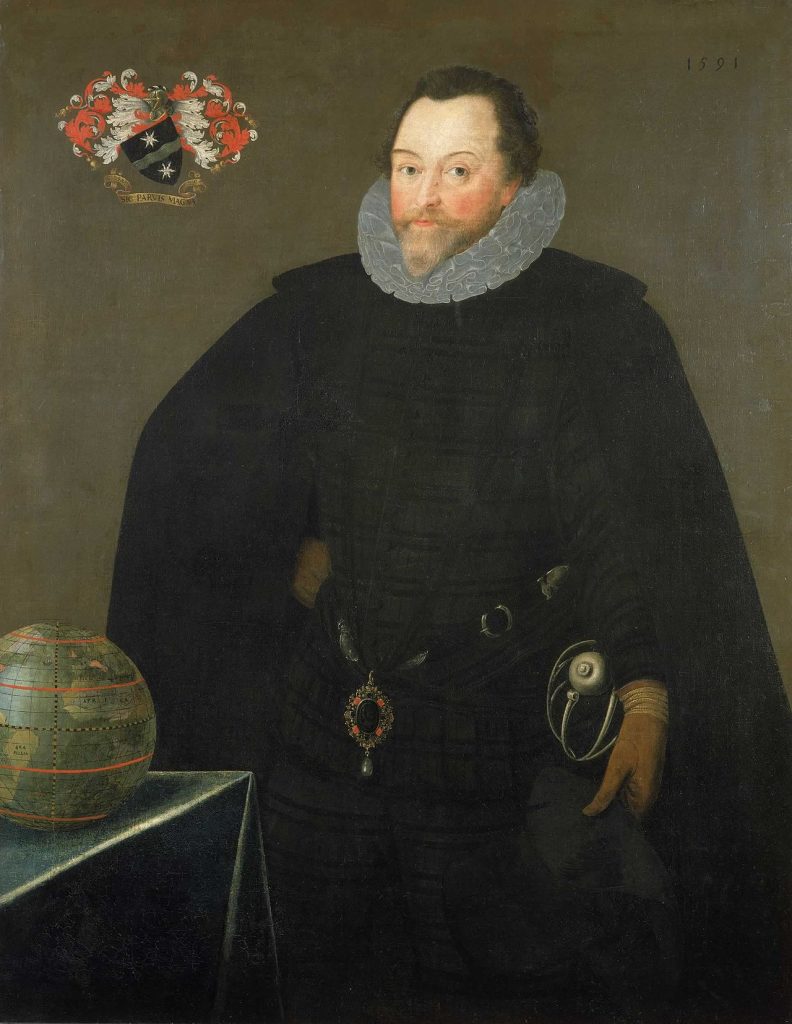
Vice Admiral Sir Francis Drake (Wiki Image).
- “It is a great advantage to an invading force if they can surprise the enemy.” – This quote reflects Drake’s strategic mind and emphasis on using surprise tactics to gain an edge over his opponents.
- “There is nothing impossible to him who will try.” – This embodies Drake’s adventurous spirit and willingness to undertake daring voyages into uncharted territories.
- “God and the sea favor bold men.” – This saying highlights Drake’s belief in divine providence and his boldness in navigating the treacherous seas.
- “I have circumnavigated the globe, not like a thief, but like a gentleman.” – This quote, possibly apocryphal, showcases Drake’s self-perception as a privateer acting with the Queen’s blessing, even though the Spanish considered him a pirate.
- “Our ship is small, our men are but a handful; for all that, we are Englishmen.” This line emphasizes Drake’s national pride and confidence in his crew’s abilities, even when facing overwhelming odds.
- “Here we see God’s sea, as broad as the capacity of my heart.” – This quote reflects Drake’s sense of awe and wonder when exploring the vastness of the oceans.
- “Unless I underline my words with deeds, they will be considered words of wind.” – This saying highlights Drake’s commitment to action and his belief that accomplishments speak louder than words.
| Year (approx.) | Age (approx.) | Events & Developments | Roles & Activities |
|---|---|---|---|
| 1540-1543 | 0 | Born in Tavistock, Devon, England. His exact birthdate is uncertain. | |
| 1549 | 9 | Moves with his family to Kent. Begins his seafaring life as an apprentice on a small trading barque. | – Learned the ropes of sailing and navigation. |
| 1560s | 20s | – Sails with his cousin, John Hawkins, on slaving voyages to West Africa and the Caribbean. <br> – Gains experience in naval warfare and trade. | – Participated in the lucrative but morally questionable slave trade. <br> – Develops his skills as a navigator and leader. |
| 1567-1569 | 27-29 | – Command ships are used in expeditions to the Caribbean and Spanish Main. <br> – Suffers losses in attacks by the Spanish at San Juan de Ulúa (Mexico). | – Begins his career as a privateer, raiding Spanish ships and settlements. <br> – Develops an intense animosity towards the Spanish. |
| 1570-1571 | 30-31 | – Leads two expeditions to the Caribbean. | – Continues his privateering activities, capturing Spanish treasure and disrupting their trade. |
| 1572-1573 | 32-33 | – Leads an expedition to Panama, capturing valuable treasure from Spanish mule trains. | – Gains a reputation as a daring and successful privateer. |
| 1577-1580 | 37-40 | – Circumnavigates the globe in a single expedition, becoming the first Englishman to do so. <br> – Explores the Pacific coast of South America, claiming land for England (Nova Albion, possibly California). <br> – Captures Spanish treasure ships in the Pacific. | – Achieved his most famous feat of exploration and navigation. <br> – Further enriches himself and England through privateering. |
| 1581 | 41 | – Knighted by Queen Elizabeth I aboard his ship, the Golden Hind. <br> – Elected Member of Parliament for Camelford. | – Receives recognition for his achievements and enters the world of politics. |
| 1585 | 45 | – Leads a major expedition to the West Indies, attacking Spanish settlements and capturing Santo Domingo. | – Demonstrates his skills as a naval commander. |
| 1587 | 47 | – Leads a daring raid on Cadiz, Spain, destroying a large part of the Spanish fleet (“singeing the King of Spain’s beard”). | – Deals a significant blow to Spanish naval power, disrupting their preparations for the Armada. |
| 1588 | 48 | – Serves as Vice Admiral in the English fleet that defeats the Spanish Armada. | – Plays a crucial role in defending England from the Spanish invasion. |
| 1589 | 49 | – Commands the English Armada in a failed attempt to counterattack Spain. | – Suffers a setback in his naval career. |
| 1590s | 50s | – Continues to serve in Parliament and advise on naval matters. | – Remains involved in politics and national defense. |
| 1595-1596 | 55-56 | – Leads a final expedition to the West Indies with John Hawkins. | – The expedition is unsuccessful, and Drake and Hawkins die from dysentery. |
| 1596 | 56 | – Dies off the coast of Portobelo, Panama (January 28th). Buried at sea. |
Sir Francis Drake: England’s Greatest Hero
(YouTube video)
Sir Francis Drake (c. 1540 – 1596) was a renowned English explorer, privateer (government-sanctioned pirate), naval officer, and politician during the Elizabethan era. Here’s a closer look at his life and achievements:
Early Life and Rise:
- Born between 1540 and 1544 in Devonshire, England, Drake likely began his seafaring career at a young age.
- He rose through the ranks of the merchant navy, eventually commanding his ship.
- By the 1560s, he was involved in privateering expeditions against Spanish ships in the Caribbean, capturing Spanish treasure and disrupting their trade routes.
Circumnavigation of the Globe:
- Drake’s most famous accomplishment is circumnavigating the globe between 1577 and 1580.
- Queen Elizabeth I secretly commissioned this voyage, hoping to find a passage around South America and challenge Spanish dominance in the Americas and the Pacific.
- During his journey, Drake explored uncharted territories, claimed land for England (including what is now California), and amassed a significant fortune through plundering Spanish settlements and ships.
Warfare with Spain:
- Upon his return, Drake became a national hero in England. His exploits heightened tensions with Spain, culminating in the Spanish Armada’s failed attempt to invade England in 1588.
- Drake played a key role in defeating the Armada, using his knowledge of seamanship and innovative tactics to harass the Spanish fleet.
Later Years and Legacy:
- Drake continued to lead military expeditions against Spanish interests in the Caribbean and the New World.
- He died of dysentery in 1596 during an unsuccessful raid on Panama.
- Drake is remembered as a daring explorer, a skilled naval commander, and a key figure in England’s rise as a maritime power.
Here are some additional points to consider:
- Drake’s methods were often ruthless, and the Spanish considered him a pirate.
- He participated in the slave trade in his early career, a stain on his legacy.
- However, he was also a skilled navigator and cartographer, contributing significantly to geographical knowledge.
Further Exploration:
If you’d like to learn more about Sir Francis Drake, here are some resources:
- Books: “Francis Drake” by Hans Koning, “The Life of Sir Francis Drake” by Julian Corbett
- Documentaries: “Sir Francis Drake: The Queen’s Pirate” by the BBC, “The True Adventures of Sir Francis Drake” by The History Channel
Sir Francis Drake YouTube Video
- Sir Francis Drake: England’s Greatest Hero by Dan Davis, History
- URL: http://www.youtube.com/watch?v=dp41jSNyokY
- Views: 893,807
- Francis Drake Sails Around the World by Epic History
- URL: http://www.youtube.com/watch?v=WiwEwSdKh0c
- Views: 1,198,005
- Francis Drake: World’s Most Controversial Pirate (Full Episode) | Pirates: Behind the Legends by National Geographic
- URL: http://www.youtube.com/watch?v=VzGTQEkul84
- Views: 696,262
- Sir Francis Drake – The Pirate Who Saved England Documentary by The People Profiles
- URL: http://www.youtube.com/watch?v=cI_K16qeIjk
- Views: 206,001
- Who Was Sir Francis Drake? | Pirates: Behind the Legends | National Geographic UK by National Geographic UK
- URL: http://www.youtube.com/watch?v=4XvemGcRV_U
- Views: 2,695
Born between 1540 and 1544 in Devonshire, England, Drake likely began his seafaring career at a young age. By the 1560s, he was involved in privateering expeditions against Spanish ships in the Caribbean, capturing Spanish treasure and disrupting their trade routes.
You’ve got the right idea about Sir Francis Drake’s early career! Here’s a breakdown of his path to becoming a notorious privateer:
- Early Apprenticeship (1550s): As you mentioned, Drake likely began his seafaring career around 18, apprenticing with the Hawkins family. This experience honed his sailing skills and exposed him to the world of trade and privateering in the Caribbean.
- The Rise of a Privateer (1560s): By the 1560s, Drake was actively involved in privateering expeditions. Privateers were essentially licensed pirates who attacked enemy ships during wartime. England and Spain were often at odds, and English privateers like Drake targeted Spanish ships and settlements in the Caribbean.
- Targeting the Spanish: Spanish galleons laden with gold and silver from the New World were prime targets for English privateers. Drake’s raids disrupted Spanish trade routes and netted him significant profits, establishing him as a skilled and daring privateer.
- Disrupting the Spanish Main: The “Spanish Main” refers to the mainland coasts of Central and South America colonized by the Spanish. This region was a hub for Spanish trade, and privateers like Drake frequently targeted it, capturing ships, seizing treasure, and even attacking Spanish settlements.
Additional Points to Consider:
- Some accounts suggest that Drake participated in slave trading voyages with the Hawkins family during the early stages of his career. However, this was a common practice then, and Drake’s later actions against the Spanish suggest a shift in focus.
- Drake’s success as a privateer undoubtedly earned him the attention of Queen Elizabeth I, who would later play a significant role in his future endeavors.
By the 1560s, Sir Francis Drake had established himself as a formidable privateer, challenging Spanish dominance in the Caribbean and amassing a reputation for daring and ruthlessness. This period marked the beginning of his rise to fame and fortune.
Queen Elizabeth I secretly commissioned this voyage, hoping to find a passage around South America and challenge Spanish dominance in the Americas and the Pacific.
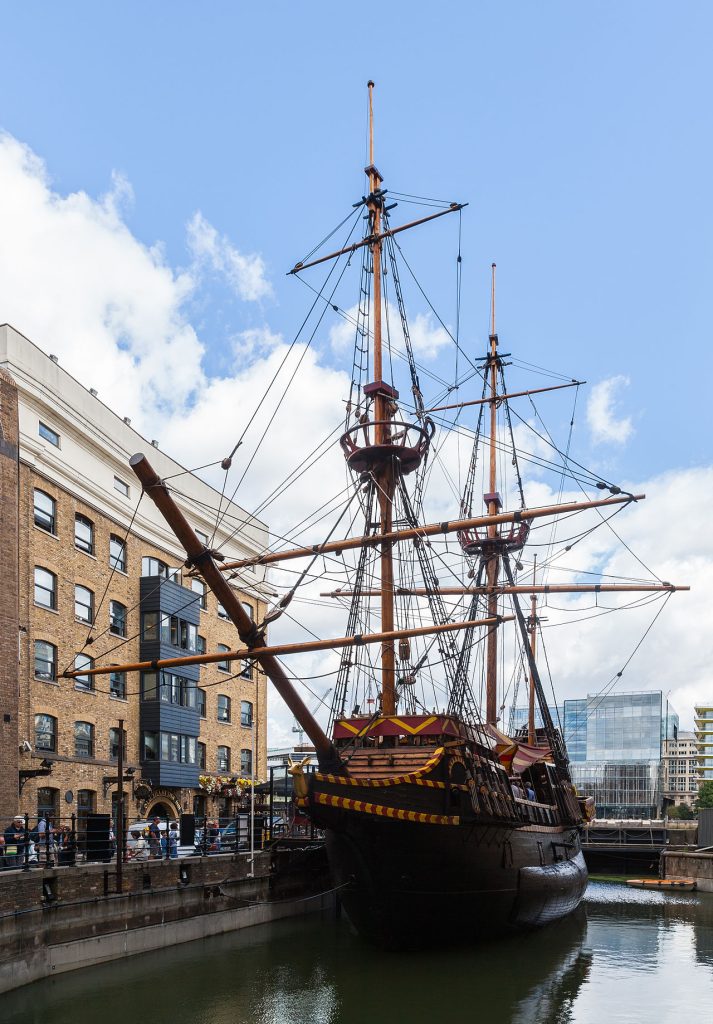
A replica of the Golden Hind at Bankside in London (Wiki Image).
You are exactly right! Queen Elizabeth I’s motives behind secretly commissioning Francis Drake’s circumnavigation voyage were multifaceted:
- Finding a Northwest Passage: One primary goal was to locate a Northwest Passage, a water route through North America that would connect the Atlantic and Pacific Oceans. This would provide a faster and safer trade route to Asia, bypassing heavily fortified Spanish trade routes around South America.
- Challenging Spanish Dominance: Spain held a near-monopoly on trade routes and resources in the Americas. Elizabeth I wanted to establish England as a major player in the exploration and potential colonization of new territories. A successful circumnavigation would demonstrate English power and challenge Spanish control of the Pacific.
- Weakening Spain: England and Spain were engaged in an ongoing political and religious conflict. Drake’s voyage could weaken Spain’s military and economic strength by disrupting Spanish trade routes and potentially attacking Spanish settlements.
- Secrecy and Plausibility: Since England and Spain were not officially at war, Elizabeth I needed to maintain a facade of peace. Commissioning the voyage as a private exploration rather than a military expedition helped her avoid a confrontation with Spain.
The Importance of Secrecy:
- Maintaining secrecy was crucial for the voyage’s success. If Spain had learned of Elizabeth I’s true intentions, it could have taken steps to sabotage the mission or even declared war on England.
The Legacy of Drake’s Voyage:
- While Drake never found a Northwest Passage, his circumnavigation achieved many of Elizabeth I’s goals. It demonstrated English navigational prowess, challenged Spanish dominance in the Pacific, and brought back valuable treasures that helped finance England’s rise as a maritime power.
In conclusion, Queen Elizabeth I’s secret commission of Drake’s voyage was a strategic move with economic, political, and military objectives. It aimed to establish England as a global power and weaken its rival, Spain.
During his journey, Drake explored uncharted territories, claimed land for England (including what is now California), and amassed a significant fortune through plundering Spanish settlements and ships. Drake’s methods were often ruthless, and the Spanish considered him a pirate.
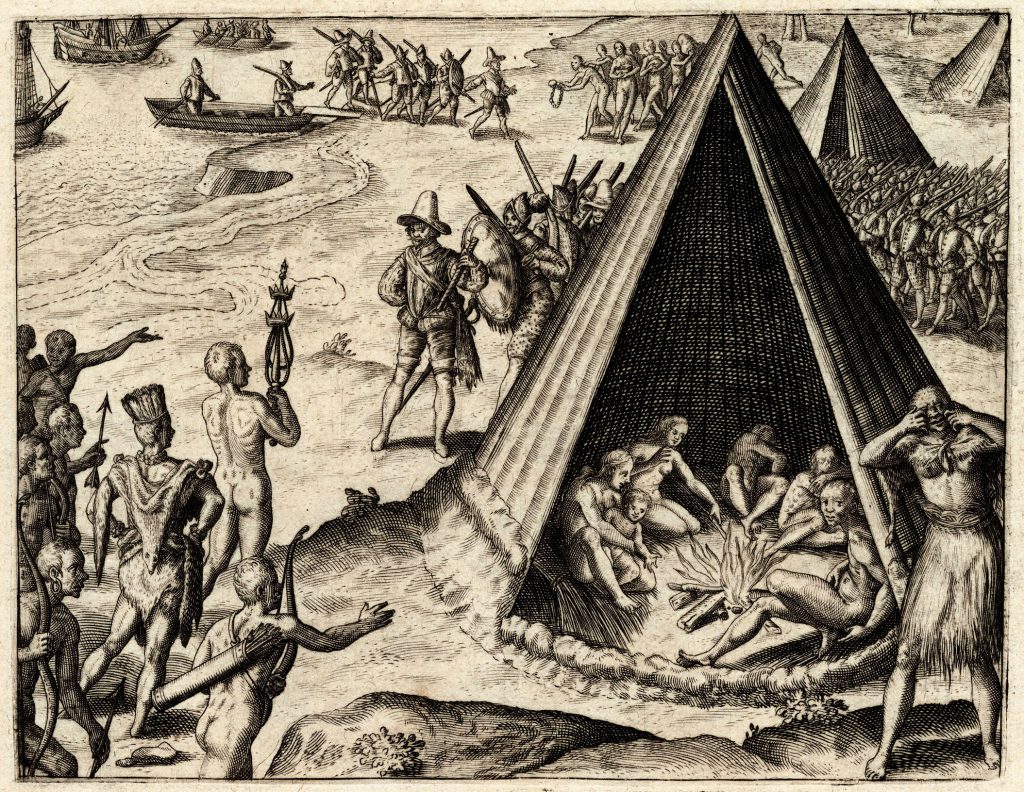
Drake’s Landing in California, engraving published in 1590 by Theodor de Bry (Wiki Image).
Absolutely! Sir Francis Drake’s circumnavigation voyage was a daring adventure filled with exploration, plunder, and international tension. Here’s a closer look at his achievements and the controversy they caused:
Exploration and Claims:
- Uncharted Waters: Drake sailed through uncharted territories, particularly along the western coast of South America. He documented his findings, expanding European knowledge of these regions.
- California Claim: In 1579, Drake landed on the California coast, claiming the land for England and naming it “New Albion.” However, England never followed up on this claim, and the territory eventually became part of Mexico and later the United States.
Plunder and Controversy:
- Spanish Fury: Drake raided Spanish settlements and captured Spanish ships throughout his journey. These actions were highly profitable for him and his crew, but the Spanish also saw them as piracy.
- Ruthless Methods: There’s evidence that Drake’s attacks on Spanish targets could sometimes be brutal. This ruthlessness further fueled Spanish outrage and solidified his image as a pirate in their eyes.
- Treasure Trove: Drake’s voyage amassed significant treasure through plunder. This treasure included gold, silver, spices, and other valuables, significantly enriching both Drake and Queen Elizabeth I.
A Two-Sided Coin:
- English Hero: In England, Drake was hailed as a hero for his daring voyage, exploration, and success in challenging Spanish dominance.
- Spanish Villain: For the Spanish, Drake was a villain and a pirate who disrupted their trade routes, plundered their settlements, and stole their riches.
A Legacy of Exploration and Controversy:
Sir Francis Drake’s circumnavigation voyage remains a landmark event in history. It showcased English navigational skills, challenged Spanish dominance, and opened up new possibilities for exploration and trade. However, the methods used, particularly the plundering of Spanish targets, cast a shadow and ensured Drake would be a controversial figure for centuries.
Upon his return, Drake became a national hero in England. His exploits heightened tensions with Spain, culminating in the Spanish Armada’s failed attempt to invade England in 1588.
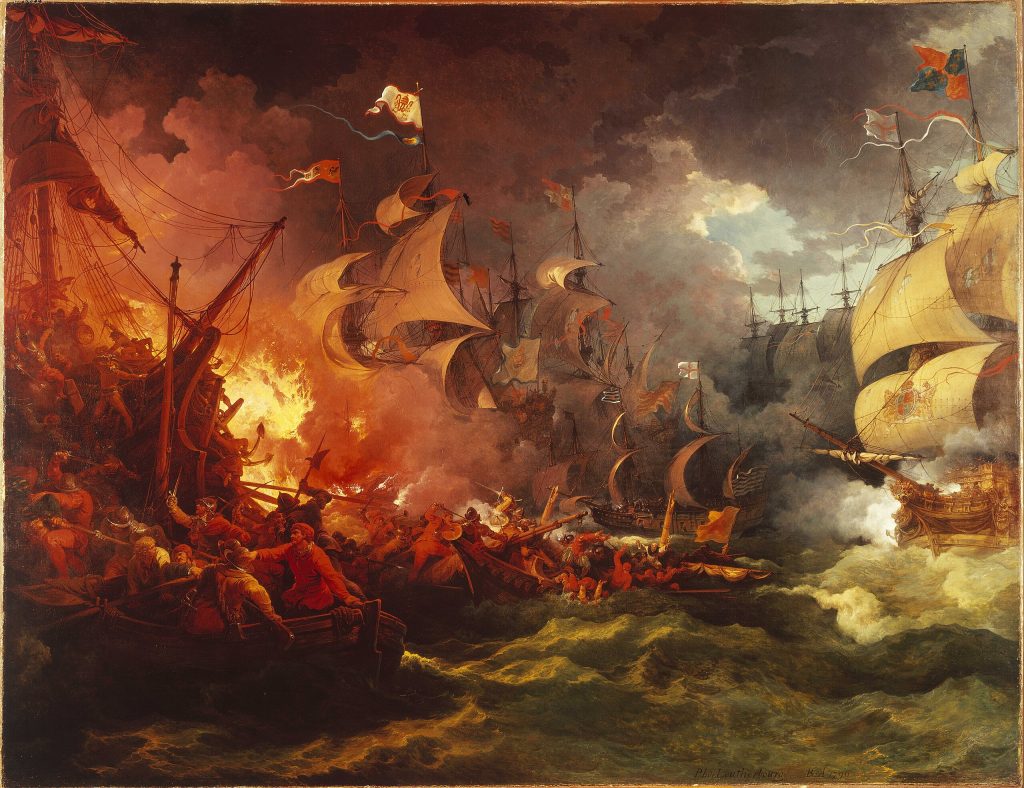
Eighteenth-century painting of the Spanish Armada, showing fire ships (Wiki Image).
You’ve got the right idea! Sir Francis Drake’s return from his circumnavigation voyage in 1580 was a turning point in his life and Anglo-Spanish relations. Let’s delve deeper:
A National Hero’s Welcome:
- England Erupts in Celebration: News of Drake’s successful voyage and the vast treasures he brought sent England into a frenzy. He was celebrated as a national hero, symbolizing English daring and exploration.
- Queen Elizabeth I Bestows Knighthood: Delighted with the success of the mission and the potential economic benefits, Queen Elizabeth I personally knighted Drake aboard his ship, the Golden Hind, in Deptford.
- A Boost for National Pride: Drake’s voyage enriched England financially and boosted national pride and confidence. It showed that England could compete with Spain as a major maritime power.
Tensions Rise with Spain:
- Spanish Fury: Spain was furious about Drake plundering their settlements and ships throughout his voyage. They viewed him as a pirate and demanded compensation for the losses incurred.
- Escalating Tensions: Queen Elizabeth I’s refusal to punish Drake and her tacit approval of his actions further strained relations between England and Spain.
- The Seeds of War: These heightened tensions, fueled by religious differences and competing colonial interests, eventually led to the Spanish Armada’s attempted invasion of England in 1588.
Drake’s Role in the Spanish Armada:
- England’s Naval Hero: By 1588, Drake had become a prominent figure in the English navy. He played a crucial role in defeating the Spanish Armada, effectively employing his knowledge of the seas and his experience in ship-to-ship combat.
A Pivotal Moment in History:
Sir Francis Drake’s circumnavigation voyage and his return as a national hero marked a significant historical turning point. It not only fueled English exploration and national pride but also served as a major catalyst for the conflict between England and Spain, culminating in the dramatic events of the Spanish Armada.
Drake played a key role in defeating the Armada, using his knowledge of seamanship and innovative tactics to harass the Spanish fleet.
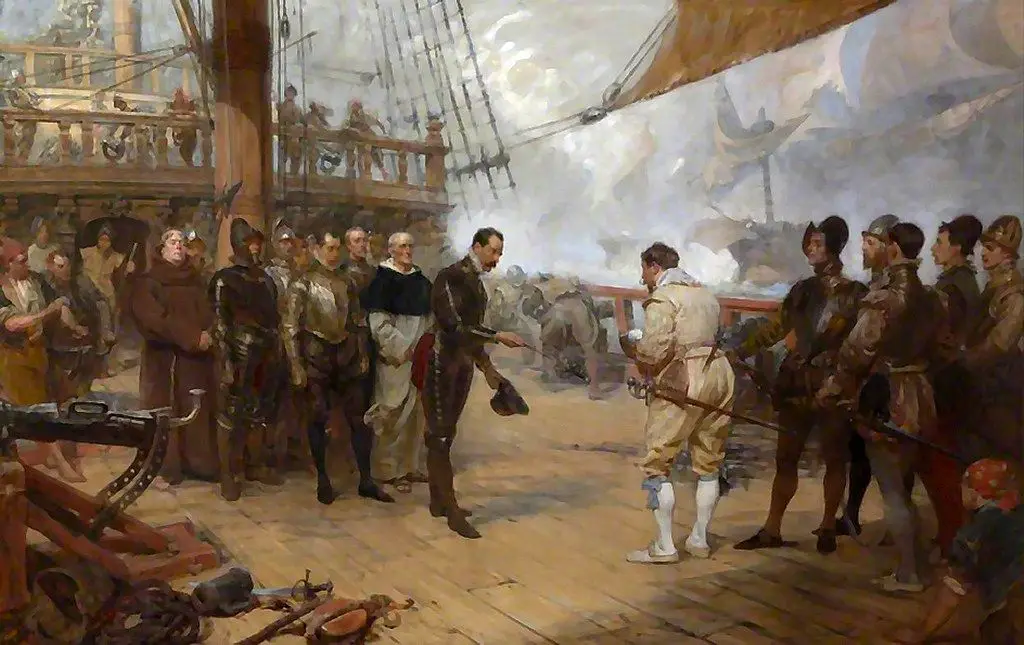
Admiral Pedro de Valdés surrendered his sword to Francis Drake aboard Revenge during the Spanish Armada’s attack in 1588. Oil on canvas by John Seymour Lucas (1889) (Wiki Image).
You are right! Sir Francis Drake’s experience and leadership were crucial in defeating the Spanish Armada in 1588. Here’s a look at his contributions:
- Seasoned Seaman: By 1588, Drake had amassed decades of experience at sea. His knowledge of sailing tactics, weather patterns, and the English coastline proved invaluable in countering the Spanish fleet.
- Innovative Tactics: Drake and other English commanders employed innovative tactics against the larger, more heavily armed Spanish ships. They harassed the Spanish galleons with smaller, faster vessels, utilizing fire ships and hit-and-run attacks to destroy their formations.
- High Morale: Drake’s reputation as a national hero and his proven leadership skills helped keep English morale high throughout the conflict. His presence on the battlefield undoubtedly inspired his fellow captains and crews.
A Thorn in the Side of the Armada:
- Disrupting the Spanish Plans: Drake’s aggressive tactics prevented the Spanish from establishing a clear advantage. They couldn’t engage in the full-scale battles they had envisioned, and their carefully planned formations were constantly under attack.
- The “Singeing of the King’s Beard” (1587): It’s important to note that Drake’s role in defeating the Armada wasn’t limited to 1588. The year before, he led a daring raid on Spanish ports in Cadiz and Corunna, destroying supplies and ships and delaying the Armada’s departure. This event, known as the “Singeing of the King’s Beard,” further demoralized the Spanish and hampered their invasion plans.
A Shared Victory:
While Drake’s contributions were significant, it’s important to remember that the defeat of the Spanish Armada was a collective effort. Other English commanders, favorable weather conditions, and logistical problems within the Spanish fleet contributed to the outcome.
Drake’s Legacy:
Sir Francis Drake’s role in defeating the Spanish Armada solidified his status as a national hero in England. He is remembered as a skilled sailor, a daring explorer, and a key figure in establishing England’s dominance as a maritime power.
Drake continued to lead military expeditions against Spanish interests in the Caribbean and the New World. Drake died of dysentery in 1596 during an unsuccessful raid on Panama.
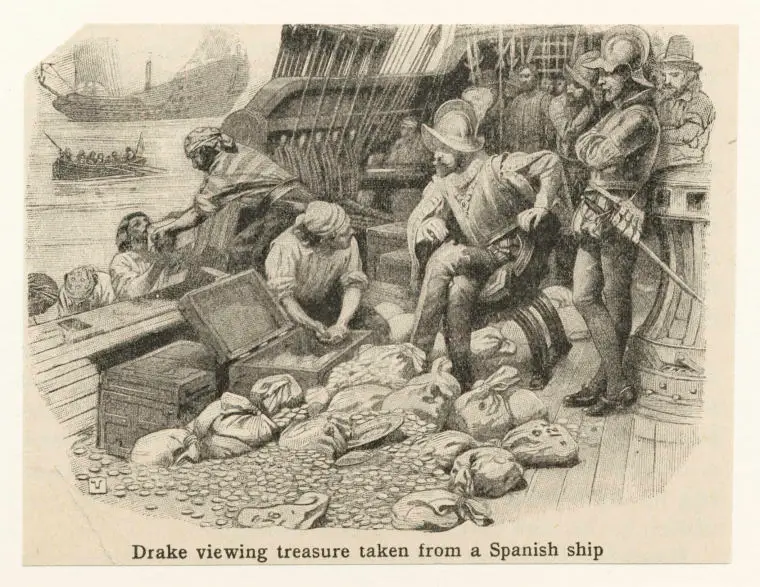
(Wiki image).
You’re right! Sir Francis Drake’s thirst for adventure and his role in the defeat of the Spanish Armada didn’t signal the end of his exploits. Here’s a look at his later expeditions:
- Continued Conflict with Spain: Following the triumph over the Armada, England and Spain remained locked in a state of war. Queen Elizabeth I continued to rely on Drake’s experience and leadership to challenge Spanish dominance at sea.
- Caribbean Raids (1585-1586): Drake led a major expedition to the Caribbean, capturing Spanish settlements, disrupting trade routes, and amassing further riches. This expedition is sometimes called his “Grand Voyage” to the Indies.
- A Failed Attack on San Juan (1585): Drake attempted to capture the well-fortified Spanish city of San Juan (present-day Puerto Rico) but was stiffly resisted. The attack was ultimately unsuccessful, and Drake suffered injuries during the battle.
- An Ill-fated Voyage to Panama (1595-1596): Drake’s final expedition targeted Panama, a key center of Spanish trade in the New World. However, the venture was plagued by illness, both for Drake and his crew. Sir Francis Drake died of dysentery off the coast of Panama in 1596.
Legacy of a Seafaring Legend:
- A Controversial Figure: Drake’s later expeditions continued to blur the lines between privateering and piracy. While celebrated in England, he remained a hated figure in Spain.
- A Maritime Pioneer: Despite the controversies, Drake’s contributions to English exploration, naval tactics, and the defeat of the Spanish Armada remain undeniable. He is remembered as a bold and innovative leader who helped shape history.
A Search for El Dorado:
Some historians believe Drake may have been motivated by a search for the legendary lost city of El Dorado during his later expeditions in the Caribbean and Panama. The allure of this mythical city of immense riches may have fueled his relentless pursuit of Spanish holdings in the New World.
Sir Francis Drake’s life and career were a whirlwind of exploration, conflict, and adventure. He remains a fascinating historical figure, remembered for his daring voyages, role in defeating the Spanish Armada, and lasting impact on exploration and naval warfare.
Drake participated in the slave trade in his early career, a stain on his legacy.
You are right. Sir Francis Drake’s involvement in the slave trade is a complex and undeniable part of his legacy. Here’s a breakdown of this issue:
- Early Voyages: Historical evidence suggests that Drake participated in slave trading voyages with his cousin John Hawkins in the 1560s. These voyages captured and transported men, women, and children from Africa to the Caribbean and Spanish colonies in the Americas to be sold as enslaved laborers.
- A Common Practice: It’s important to acknowledge that the slave trade was a horrific but widespread practice during this period. Many European nations, including England, Spain, and Portugal, were actively involved.
- A Shift in Focus?: While Drake participated in the slave trade early in his career, there’s no clear evidence he continued this practice later in life. His focus has shifted towards privateering and exploration.
- A Stain on His Legacy: Regardless of the extent of his involvement, Drake’s participation in the slave trade remains a dark stain on his legacy. It was a brutal and inhumane practice that caused immense suffering.
A Complex Legacy:
Sir Francis Drake’s accomplishments as an explorer, privateer, and naval leader are undeniable. However, his involvement in the slave trade cannot be ignored. A complete understanding of his legacy requires acknowledging his life and career’s positive and negative aspects.
Open for Discussion:
Historians debate the extent of Drake’s involvement in the slave trade and its weight compared to his other achievements. Some argue that his later contributions outweigh this early blemish, while others believe it remains a significant mark against his character.
This is an opportunity to explore different perspectives and have a nuanced discussion about historical figures who may have both positive and negative qualities.
Drake is remembered as a daring explorer, a skilled naval commander, and a key figure in England’s rise as a maritime power.
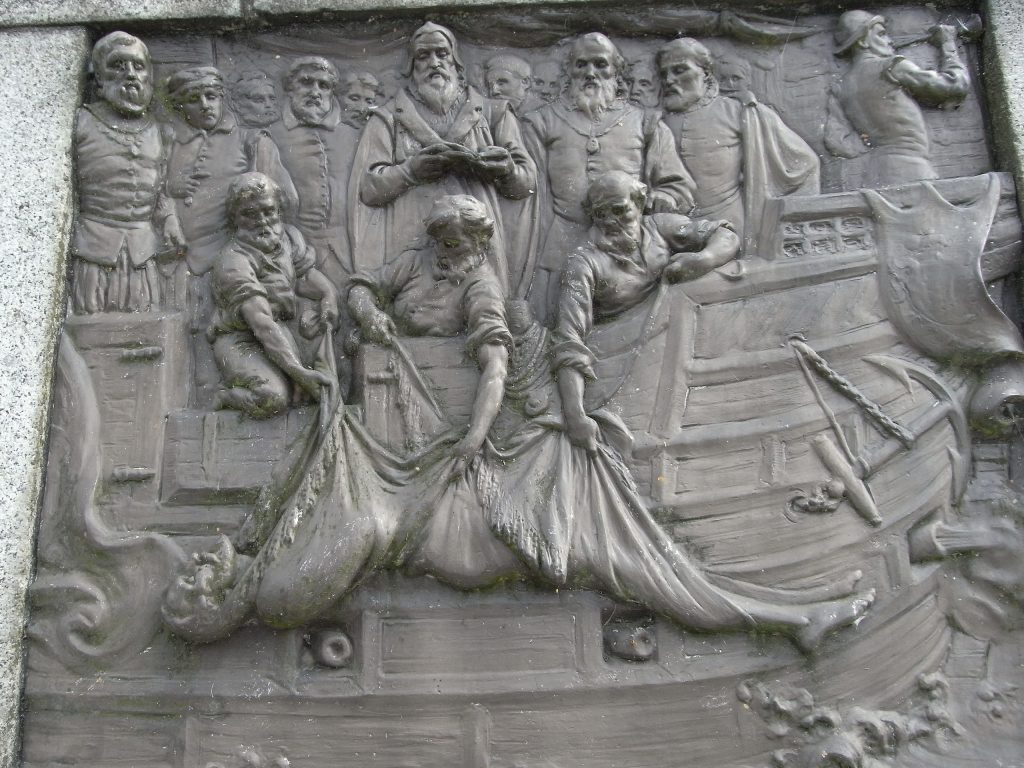
Drake’s burial was at sea off Portobello. A bronze plaque by Joseph Boehm, 1883, is at the base of the Drake statue in Tavistock (Wiki Image).
You’ve captured the essence of Sir Francis Drake’s legacy! Here’s a summary of the key points we’ve discussed:
A Daring Explorer:
- Drake’s circumnavigation voyage was a landmark achievement in exploration. It expanded European knowledge of the world and paved the way for future exploration endeavors.
- He explored uncharted territories, including parts of South America and the coast of what is now California.
A Skilled Naval Commander:
- Drake’s experience and leadership were instrumental in defeating the Spanish Armada, a pivotal historical moment.
- He employed innovative tactics and used his knowledge of the seas to great effect.
A Key Figure in England’s Rise as a Maritime Power:
- Drake’s exploits challenged Spanish dominance at sea and helped establish England as a major naval power.
- He disrupted Spanish trade routes, plundered their settlements, and boosted English national pride.
A Complex Legacy:
- It’s important to acknowledge the dark side of Drake’s legacy, including his participation in the slave trade early in his career.
- However, his exploration, privateering, and naval leadership accomplishments remain significant.
A Controversial Figure:
- Drake was a hero in England but a villain in Spain. His methods, particularly the plundering of Spanish targets, were often ruthless.
A Lasting Impact:
- Sir Francis Drake’s life and career continue to fascinate people today. He is remembered as a bold and innovative figure who left his mark on exploration, naval warfare, and the rise of the British Empire.
By understanding both the positive and negative aspects of his legacy, we can gain a complete picture of Sir Francis Drake, a complex and consequential historical figure.
Ching Shih: The Pirate Queen Who Ruled the Seas
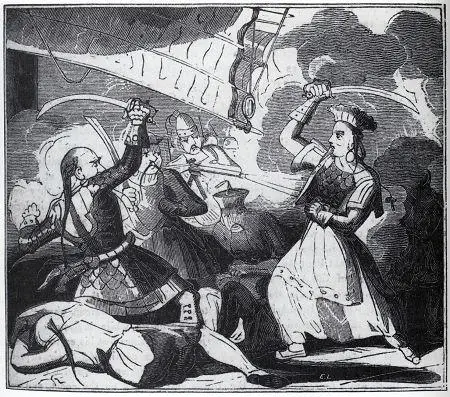
Zheng Yi Sao (Ching Shih) in an 1836 illustration (Wiki Image)
- “The sea is a harsh mistress but a fair one. She rewards those who respect her power and punishes the foolish.” – This quote reflects Ching Shih’s understanding of the dangers and opportunities of life at sea.
- “A ship without a strong rudder is lost at sea. A crew without discipline is a ship doomed to flounder.” – This saying highlights Ching Shih’s emphasis on discipline and leadership as the foundation of a successful pirate fleet.
- “Men fear a storm, but a wise captain learns to navigate its fury.” – This line showcases Ching Shih’s strategic mind and ability to overcome challenges.
- “We fight for survival, not for glory. But let them underestimate us at their peril.” – This quote emphasizes Ching Shih’s practicality and willingness to defend her people against any threat.
- “There is more power in unity than in a thousand cannons.” – This saying reflects Ching Shih’s ability to unite a diverse group of pirates under her banner.
- “I may be a woman, but on the open sea, respect is earned, not given.” – This line challenges gender stereotypes and highlights Ching Shih’s determination to be a respected leader in a male-dominated world.
- “Sometimes, the greatest victory is knowing when to lay down your sword.” – This quote reflects Ching Shih’s pragmatism and her successful negotiation of a peaceful retirement for herself and her crew.
| Year (approx.) | Age (approx.) | Events & Developments | Pirate Activities |
|---|---|---|---|
| 1775 | 0 | Born Shi Yang in Guangdong province, China. Her early life is shrouded in mystery, but she likely faced hardship and poverty. | |
| 1797 | 22 | – Begins working as a prostitute in a floating brothel in Canton (Guangzhou). | |
| 1801 | 26 | – Marries Zheng Yi, an influential pirate captain who leads the Red Flag Fleet. <br> – Negotiates a prominent role in the pirate confederation, gaining authority and influence. | – She begins her involvement in piracy by demonstrating leadership and strategic skills. |
| 1804 | 29 | – Zheng Yi unites various pirate fleets under the Red Flag Fleet’s banner, creating a formidable force. | – Ching Shih plays a key role in consolidating power and establishing a code of conduct for the pirates. |
| 1807 | 32 | – Zheng Yi dies. <br> – Ching Shih takes control of the Red Flag Fleet, consolidating her power and becoming the undisputed leader. | – Demonstrates exceptional leadership and strategic acumen, commanding a vast fleet and tens of thousands of pirates. |
| 1807-1810 | 32-35 | – Commands the Red Flag Fleet at its peak, controlling coastal regions of South China. <br> – Imposes strict rules and regulations on her pirate crews. <br> – Engages in battles with the Chinese Qing Navy, Portuguese Navy, and British East India Company. | – Her fleet dominates the South China Sea, raiding ships and coastal towns. <br> – She is known for her ruthlessness and effective leadership. |
| 1810 | 35 | – Negotiates a surrender with the Qing government. <br> – Secures amnesty for her pirates and retains much of her wealth. | – Recognizes the changing political landscape and strategically negotiates a favorable surrender, ensuring her survival and prosperity. |
| 1810-1844 | 35-69 | – Marries Cheung Po Tsai, her adopted son and a powerful pirate captain. <br> – Opens a gambling house and continues to exert influence in the region. | – Retires from piracy but remains a respected figure in the community. |
| 1844 | 69 | Dies in Guangdong province. |
Ching Shih (also known as Shi Yang, Cheng I Sao, Zheng Yi Sao) was a legendary Chinese pirate who dominated the South China Sea in the early 19th century. Here’s a breakdown of her remarkable life:
Early Life of Mystery:
- Details about Ching Shih’s early life are unclear. Born sometime around 1775, she likely came from a poor background.
- Historical accounts suggest she may have worked in a brothel in Canton (Guangzhou) before entering the world of piracy.
Rise to Power:
- In 1801, Ching Shih married the notorious pirate captain Cheng I. She quickly rose through the ranks, demonstrating exceptional leadership and tactical skills.
- Upon Cheng I’s death in 1807, Ching Shih took full command of his vast pirate fleet, estimated to include over 1,800 ships and 80,000 pirates.
A Formidable Force:
- Ching Shih’s leadership was characterized by strict discipline, a meritocratic system that rewarded competence, and a strong emphasis on protecting women within her fleet.
- Her pirates plundered merchant ships, disrupted trade routes, and even challenged the Qing Dynasty’s naval power for control of the South China Sea.
Negotiating an End:
- Facing pressure from the Qing government and internal conflicts, Ching Shih negotiated with the authorities in 1810.
- She secured a remarkable deal that allowed her and her followers to retain a significant portion of their fleet and retire with amnesty.
Later Life and Legacy:
- Ching Shih settled in Macau with her second husband, a former pirate captain, Zhang Bao.
- She lived a relatively peaceful life until her death around 1844.
- Ching Shih’s legacy is that of a powerful woman who defied societal norms and carved her path in the male-dominated world of piracy. She is remembered as a brilliant leader, a shrewd negotiator, and one of the most successful pirates in history.
Here are some additional points to consider:
- Ching Shih’s story is often romanticized, and details about her ruthlessness and brutality are debated.
- However, her exceptional leadership and ability to unite a massive pirate force are undeniable.
Further Exploration:
If you’d like to learn more about Ching Shih, here are some resources:
- Books: “Empress of the Seas” by Kathryn Mullin, “A Pirate’s Daughter” by Louise Leitch
- Documentaries: “Ching Shih: Pirate Queen of the China Seas” by National Geographic, “Real Pirates of the Caribbean” by The History Channel
Ching Shih YouTube Video
- Ching Shih: The Pirate Widow Menace of the South China Sea by Biographics
- URL: http://www.youtube.com/watch?v=acojc6aZjgE
- Views: 255,618
- Epic Moments in History – Ching Shih, Rise of the Pirate Queen by Invicta
- URL: http://www.youtube.com/watch?v=KsnV-cOOEDU
- Views: 151,363
- China’s Biggest Female Pirate: Ching Shih! | Corpse Talk by Cartoons for Kids
- URL: http://www.youtube.com/watch?v=HlRpQ87StV4
- Views: 148,147
- Ching Shih – Pirate Queen of Chinese History by Raconteur – Mythology & History
- URL: http://www.youtube.com/watch?v=ID3uG0_E1xA
- Views: 8,504
Details about Ching Shih’s early life are unclear. Born sometime around 1775, she likely came from a poor background. Historical accounts suggest she may have worked in a brothel in Canton (Guangzhou) before entering the world of piracy.
That’s right! Ching Shih’s early life remains shrouded in mystery. Here’s a breakdown of the known (and somewhat debated) aspects:
- Birth and Origins: Historical estimates place her birth around 1775, possibly under the name Shi Yang. Details about her birthplace and family are still being determined, but most accounts suggest she came from a poor background.
- Life in Canton: There’s strong evidence that Ching Shih spent some time in Canton (modern-day Guangzhou) before becoming a pirate. The exact nature of her work there is debated, with some accounts suggesting she was a prostitute or worked in a brothel.
- Limited Sources: Unfortunately, there are no firsthand accounts or official documents from Ching Shih’s early life. Much of what we know comes from later sources, some of which may be embellished or unreliable.
Possible Scenarios:
While the specifics are unclear, historians have proposed a few possibilities for Ching Shih’s early life:
- Life on the Water: Canton was a major port city, and it’s possible Ching Shih grew up in a family involved in the maritime industry. This could explain her familiarity with the sea and the workings of port life.
- Forced Prostitution: Poverty and desperation may have forced her into prostitution at a young age. This experience could have honed her social skills and resourcefulness, later serving her as a pirate leader.
The Importance of Context:
Regardless of the specifics, it’s important to understand the social and economic realities of 18th-century China. Poverty and limited opportunities for women likely shaped Ching Shih’s early life and pushed her towards unconventional means of survival.
The Rise of a Pirate Queen:
While the details of her early life remain murky, Ching Shih’s story takes a dramatic turn when she enters the world of piracy. She marries a powerful pirate captain, Zheng Yi, and eventually becomes the leader of a vast and formidable pirate fleet, challenging the Qing Dynasty and leaving her mark on history.
In 1801, Ching Shih married the notorious pirate captain Cheng I. She quickly rose through the ranks, demonstrating exceptional leadership and tactical skills.
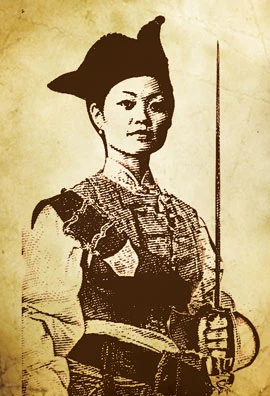
Ching Shih (huntforall39.fandom.com/wiki/Ching_Shih)
You’re right! Ching Shih’s rise to power is a fascinating story of ambition, skill, and ruthlessness. Here’s a closer look at her ascent within the pirate world:
- Marriage to Captain Cheng I: Around 1801, Ching Shih married the already-established pirate captain, Cheng I. This marriage wasn’t just about love; it was a strategic move that allowed her entry into the male-dominated world of piracy.
- Leadership Potential Recognized: While details are debated, Ching Shih quickly impressed those around her with her intelligence, organizational skills, and perhaps even a forceful personality. She wasn’t just a pirate captain’s wife but a leader in her own right.
- Rising Through the Ranks: Ching Shih’s exceptional leadership qualities didn’t go unnoticed. She rose through the ranks of Cheng I’s pirate confederation, gaining the respect and loyalty of other pirates. Her tactical skills and strategic thinking likely contributed to her growing influence.
- A Formidable Partnership: Ching Shih and Cheng I became a formidable partnership. He provided the established network and experience within the pirate world while she brought fresh ideas, leadership, and possibly a more ruthless streak to their operations.
Possible Reasons for Her Rise:
There are a few reasons why Ching Shih may have risen so quickly within the pirate ranks:
- Strategic Marriages: Pirate communities often relied on marriages or alliances to solidify power and expand influence. Ching Shih’s marriage to Cheng I may have been a strategic move that allowed her to gain a foothold in the power structure.
- Leadership Vacuum: Some accounts suggest that Cheng I’s health declined after marriage. This may have created a leadership vacuum that Ching Shih was able to fill with her skills and ambition.
- Ruthlessness and Efficiency: While some portrayals romanticize Ching Shih, others suggest she could be a ruthless and efficient leader. She may have implemented stricter discipline and more effective strategies, which garnered her respect and solidified her position.
The Red Flag Fleet:
Under Ching Shih and Cheng I’s combined leadership, the pirate confederation grew significantly, becoming known as the Red Flag Fleet. This powerful force dominated the South China Sea for over a decade. Next, we’ll explore their exploits and Ching Shih’s rise to even greater power.
Upon Cheng I’s death in 1807, Ching Shih took full command of his vast pirate fleet, estimated to include over 1,800 ships and 80,000 pirates.
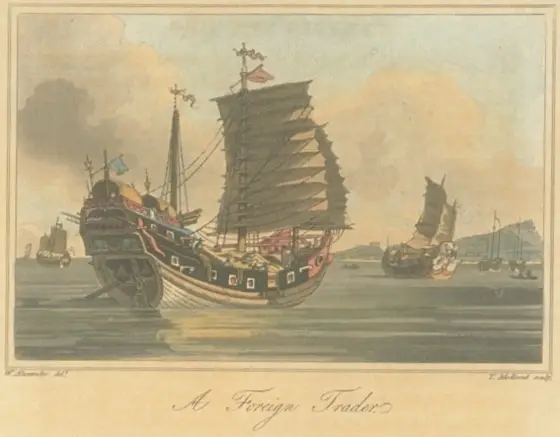
A Chinese junk (Wiki Image).
There is a slight discrepancy in the number of ships under Ching Shih’s command. Here’s what we know:
- Leadership Transition: You’re right about Ching Shih taking full command of the pirate fleet after Cheng I’s death in 1807. This was a bold move for a woman in a male-dominated world, but her skills and influence earned her the pirates’ respect.
- Fleet Size Estimates: Historical accounts vary somewhat regarding the exact size of the fleet Ching Shih inherited.
- 1,800 Ships (junk) and 80,000 pirates: This is a commonly cited figure, suggesting a truly massive pirate armada under her command.
- 400 Ships (junk) and 40,000-60,000 pirates: Some sources suggest a smaller fleet size, closer to 400 ships, still a significant force.
Possible Reasons for the Discrepancy:
- Lack of Precise Records: Pirate activities were inherently secretive, and meticulous records needed to be prioritized. Estimates of fleet size might be based on secondary sources or intelligence reports from the Qing Dynasty, which may have been partially accurate.
- Fluctuations in Size: The pirate fleet’s size likely wasn’t static. It could have fluctuated depending on recruitment efforts, successful raids that brought in new ships and crews, or losses in battles with Qing forces.
Regardless of the Exact Number:
- A Formidable Force: Even with the lower estimate of 400 ships, Ching Shih’s Red Flag Fleet was a formidable force that challenged the Qing Dynasty’s control over the South China Sea.
- A Complex Organization: The fleet wasn’t just about the number of ships. It likely included a diverse range of vessels, from heavily armed junks to smaller, faster ships for scouting and raiding. Additionally, the number of pirates would have included fighters, cooks, navigators, and other personnel necessary to keep the fleet operational.
Ching Shih’s Legacy:
Ching Shih’s leadership of the Red Flag Fleet is a remarkable feat in history. She defied expectations, commanded a vast pirate empire, and negotiated a peaceful surrender with the Qing Dynasty on her terms. While the exact number of ships under her command may be debated, her impact on piracy and the Qing Dynasty is undeniable.
Ching Shih’s leadership was characterized by strict discipline, a meritocratic system that rewarded competence, and a strong emphasis on protecting women within her fleet.
You’ve got a great understanding of Ching Shih’s unique leadership style! Here’s a breakdown of the key points you mentioned:
- Strict Discipline: Ching Shih maintained strict order within her vast pirate fleet, the Red Flag Fleet. This discipline ensured the smooth operation of the ships, the success of raids, and the overall survival of the fleet in a hostile environment. Rules often included harsh punishments for disobedience or piracy against civilians.
- Meritocracy: Ching Shih implemented a meritocratic system, unlike some pirate captains who ruled solely through fear or intimidation. She valued competence and rewarded those who demonstrated leadership, sailing, navigation, and combat skills. This approach helped her attract and retain talented individuals, further strengthening the Red Flag Fleet.
- Protection of Women: In a world dominated by men, Ching Shih established clear rules protecting women within her fleet. Rape and forced prostitution were strictly forbidden, and women who chose to become pirates were treated with respect. This approach was rather unique for the time period and may have attracted women seeking a safer alternative to life on land.
Additional Points to Consider:
- Code of Conduct: Ching Shih established a formal code of conduct that all members of the Red Flag Fleet had to follow. This code outlined rules, punishments, and even profit-sharing agreements, creating a sense of order and fairness within the fleet.
- Leadership by Example: Ching Shih wasn’t just a leader who gave orders; she was known to participate in planning raids and even join battles herself. This leadership, by example, likely inspired loyalty and respect from her crew.
- Negotiation and Diplomacy: Ching Shih was a formidable pirate leader, but she also understood the value of negotiation and diplomacy. She established communication channels with the Qing Dynasty government and even engaged in trade agreements with coastal villages, demonstrating her strategic thinking.
A Complex and Effective Leader:
Ching Shih’s leadership style was a complex blend of strictness, fairness, and strategic thinking. She understood the need for discipline but also valued competence and loyalty. By protecting women within her fleet, she created a more attractive environment for potential recruits. Ultimately, her leadership proved highly effective, allowing her to build and maintain a powerful pirate empire for nearly a decade.
Her pirates plundered merchant ships, disrupted trade routes, and even challenged the Qing Dynasty’s naval power for control of the South China Sea.
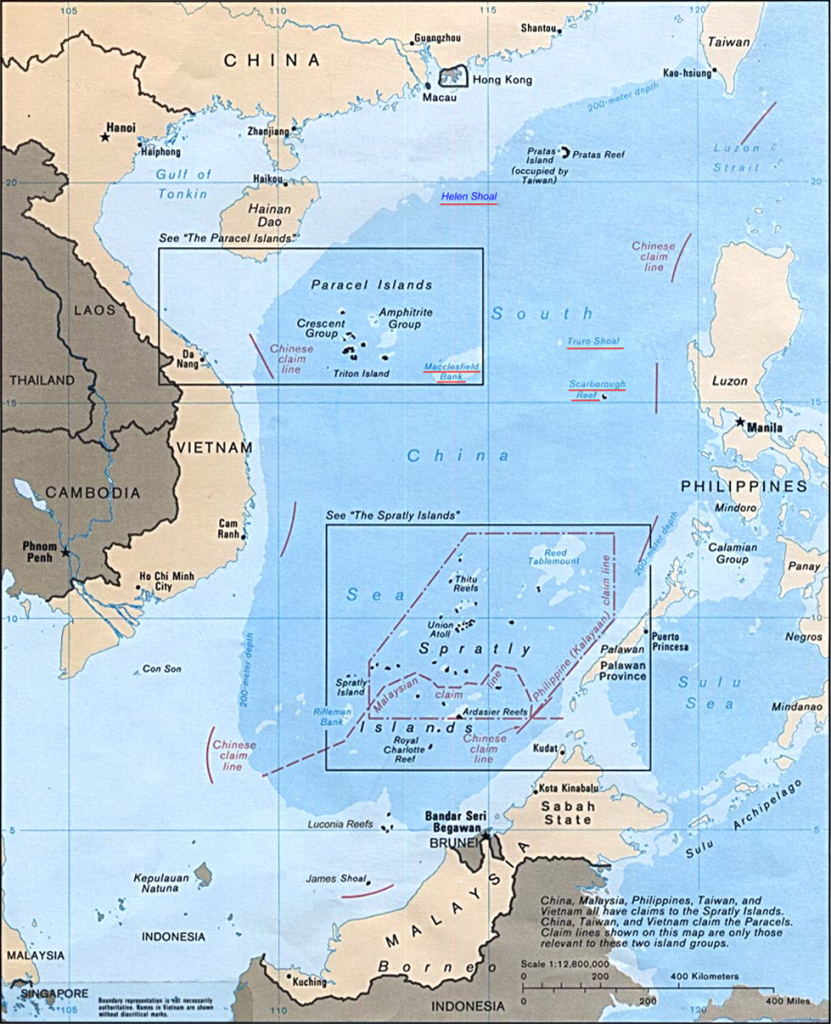 Location of the South China Sea Islands (Wiki Image).
Location of the South China Sea Islands (Wiki Image).
You’re right! Ching Shih’s Red Flag Fleet was a formidable force that disrupted the status quo in the South China Sea. Here’s a closer look at their activities:
- Preying on Merchant Ships: The Red Flag Fleet primarily targeted merchant ships sailing in the South China Sea. These ships often carried valuable cargo, such as silk, porcelain, and tea. Ching Shih’s pirates plundered these ships for their riches, amassing a significant fortune.
- Disrupting Trade Routes: The constant threat posed by the Red Flag Fleet made maritime trade routes in the region highly dangerous. Many merchants were forced to pay protection money to Ching Shih or reroute their ships entirely. This disruption of trade routes had a significant economic impact on the Qing Dynasty and other regional powers.
- Challenging the Qing Dynasty: The Qing Dynasty, which ruled China then, saw Ching Shih’s pirate fleet as a major threat to its authority and control over trade in the South China Sea. The Red Flag Fleet clashed with Qing Dynasty naval forces numerous times, and Ching Shih’s pirates emerged victorious in many of these battles.
Beyond Plunder:
- Blockades and Taxes: In addition to outright plunder, Ching Shih’s fleet sometimes imposed blockades on ports controlled by the Qing Dynasty. These blockades restricted trade and put pressure on the Qing government. The Red Flag Fleet may have also levied taxes on some coastal villages in exchange for safe passage.
- A Complex Relationship: The relationship between the Red Flag Fleet and the Qing Dynasty was complex. There were periods of open conflict but also instances of negotiation and cooperation. Ching Shih sometimes offered her services to the Qing government to help quell rebellions in exchange for amnesty or concessions.
A Formidable Force:
Ching Shih’s leadership and the capabilities of the Red Flag Fleet made them a dominant power in the South China Sea for nearly a decade. They disrupted trade, challenged Qing Dynasty authority, and amassed a considerable fortune through piracy. Their story continues to be a fascinating example of maritime power and resistance in Chinese history.
Faced with pressure from the Qing (Jiaqing) government and internal conflicts, Ching Shih negotiated with the authorities in 1810. She secured a remarkable deal that allowed her and her followers to retain a significant portion of their fleet and retire with amnesty.
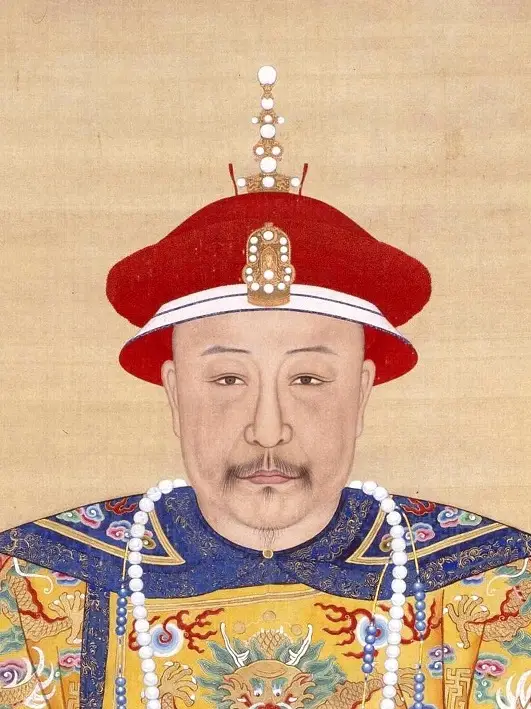
Jiaqing Emperor (Wiki Image).
You’re right! Faced with mounting pressure and a changing landscape, Ching Shih made a shrewd decision that secured a remarkable outcome for her and her followers. Let’s delve deeper into the details of her negotiation with the Qing government:
Mounting Pressure:
- Qing Dynasty Efforts: The Qing Dynasty had been actively trying to suppress piracy in the South China Sea for years. They employed various strategies, including military campaigns, offering rewards for capturing pirate leaders, and even attempting to sow discord within the Red Flag Fleet. These efforts, combined with internal conflicts within the pirate confederation, began to take a toll on Ching Shih’s power.
- Internal Conflicts: There were growing tensions within the Red Flag Fleet. Some pirate captains chafed under Ching Shih’s leadership, and there were disagreements about the future of the confederation. These internal conflicts weakened the Red Flag Fleet from within and made it more vulnerable to external pressure.
A Negotiation for Survival:
- Strategic Decision: Recognizing the changing situation, Ching Shih decided to negotiate with the Qing Dynasty. This move allowed her to secure a better deal for herself and her followers than they might have received if they had been defeated militarily.
Terms of the Deal:
- Amnesty and Pardons: Ching Shih negotiated an offer of amnesty for herself, her crew, and their families. This meant that they wouldn’t be punished for their pirating activities.
- Retention of Wealth and Ships: Remarkably, Ching Shih retained a significant portion of the Red Flag Fleet’s accumulated wealth and even kept many ships. This allowed her followers to reintegrate into society with some financial security.
- Retirement from Piracy: The most crucial term was the agreement to disband the Red Flag Fleet and end their pirating activities.
A Win-Win Situation:
- Qing Dynasty Benefits: The Qing Dynasty benefited from the deal by eliminating a major threat to its control of the South China Sea. It also avoided the costs and casualties of a prolonged military campaign against the Red Flag Fleet.
- Ching Shih’s Success: The deal was a success for Ching Shih. She ensured the safety of herself and her followers, secured some wealth, and avoided the risk of being captured and possibly executed.
A Remarkable Outcome:
Ching Shih’s ability to negotiate a favorable deal with the Qing Dynasty after years of piracy is a testament to her intelligence, leadership skills, and strategic thinking. She secured a peaceful future for herself and many followers, leaving a legacy as one of the most successful pirates in history.
Ching Shih settled in Macau with her second husband, a former pirate captain, Zhang Bao. She lived a relatively peaceful life until she died in 1844.
You’ve nailed it! Here’s a summary of Ching Shih’s later life:
- Peaceful Retirement: After negotiating a remarkable deal with the Qing Dynasty, Ching Shih settled in Macau with her second husband, Zhang Bao, a former pirate captain. Macau offered a haven away from Qing control.
- Business Ventures: Historical accounts suggest Ching Shih may have invested her wealth in various businesses in Macau, potentially including gambling houses and opium dens. This allowed her to maintain a comfortable lifestyle after her pirating days.
- Lingering Connections?: There’s some speculation that Ching Shih may have retained some connections with the criminal underworld even after retiring from piracy. However, the extent of this involvement remains unclear.
- Death in 1844: Ching Shih lived a relatively peaceful life in Macau until she died in 1844 at around 69.
A Legacy of Power and Defiance:
Ching Shih’s story transcends her pirating years. She stands as a symbol of power, defiance, and strategic brilliance. She rose from humble beginnings to become a formidable leader in a male-dominated world. Her ability to negotiate a safe haven for herself and her followers after years of defying the Qing Dynasty remains a testament to her intelligence and shrewdness.
A Continuing Fascination:
Although some aspects of her life remain shrouded in mystery, Ching Shih’s legacy continues to captivate us. She is a source of inspiration for writers and filmmakers, and her story continues to be explored in popular culture.
Ching Shih’s life offers a fascinating glimpse into a bygone era and challenges our understanding of piracy and leadership.
Ching Shih’s legacy is that of a powerful woman who defied societal norms and carved her path in the male-dominated world of piracy. She is remembered as a brilliant leader, a shrewd negotiator, and one of the most successful pirates in history.
You’ve captured the essence of Ching Shih’s legacy perfectly. Here’s a breakdown of the key points:
Defying Expectations: Ching Shih rose from a life of obscurity to become a powerful leader in a world dominated by men. She shattered gender norms and proved her competence through strategic thinking, leadership skills, and unwavering determination.
Brilliant Leadership: Her leadership style combined strict discipline with a meritocratic system that rewarded competence. She also took steps to protect women within her fleet, creating a unique environment for the time period. These qualities attracted talented individuals and helped her build a vast and successful pirate empire.
Shrewd Negotiator: Ching Shih’s ability to negotiate a favorable deal with the Qing Dynasty after years of piracy exemplifies her shrewdness and strategic thinking. She secured a peaceful future for herself and many followers, avoiding capture and potential execution.
A Pioneering Pirate: Ching Shih’s Red Flag Fleet was a formidable force that challenged the status quo in the South China Sea. They disrupted trade routes for years and amassed a significant fortune. Her story stands out as one of history’s most successful pirating endeavors.
A Legacy of Inspiration: Ching Shih continues to inspire many. She is a symbol of female empowerment, defying societal expectations and carving her own path. Her story is explored in literature, film, and popular culture.
A Complex Figure: It’s important to acknowledge that piracy involved violence and disrupted legitimate trade. However, Ching Shih’s legacy is multifaceted. She was a product of her time and circumstances, and her story offers a window into the complexities of 19th-century China.
A Continuing Discussion: The debate surrounding Ching Shih’s legacy will likely continue. Historians and enthusiasts will continue to analyze her achievements, leadership style, and impact on the world around her.
Understanding Ching Shih’s brilliance and complexities gives us a richer appreciation for this remarkable historical figure.
Similarities and Differences Between Blackbeard, Sir Francis Drake, and Ching Shih are compared.
Similarities:
- Maritime Background: All three figures were heavily involved in maritime activities. Blackbeard and Ching Shih were notorious pirates, while Sir Francis Drake was a privateer and explorer commissioned by the English Crown.
- Notoriety: They gained significant notoriety during their lifetimes for their exploits at sea. They were feared and respected figures in maritime circles.
- Leadership: Blackbeard, Sir Francis Drake, and Ching Shih were influential leaders who commanded the loyalty of their crews. They demonstrated strong leadership skills in navigating the challenges of piracy and naval warfare.
- Impact on Maritime History: Each figure left a lasting effect on maritime history. Blackbeard’s actions contributed to the legend of piracy in the Caribbean, Sir Francis Drake’s circumnavigation and victories bolstered English naval power, and Ching Shih’s leadership reshaped the pirate landscape in East Asia.
Differences:
- Nationality and Background: Blackbeard was English and known for his activities in the Caribbean. Sir Francis Drake was also English and renowned for his circumnavigation and victories against the Spanish Armada. Ching Shih was Chinese and operated primarily in the South China Sea.
- Legal Status: The English Crown commissioned Sir Francis Drake as a privateer, essentially a legalized pirate with permission to attack enemy ships. Blackbeard and Ching Shih operated outside the law as notorious pirates.
- Method of Operation: While all three figures engaged in maritime activities, their methods differed. Blackbeard and Ching Shih primarily targeted merchant vessels for plunder, while Sir Francis Drake’s activities ranged from exploration to attacking Spanish treasure ships.
- Legacy and Representation in Pop Culture: Blackbeard, Sir Francis Drake, and Ching Shih have been portrayed in various ways in popular culture. Blackbeard is often depicted as the archetypal pirate in literature and film. Sir Francis Drake is celebrated as a hero in England and has been the subject of numerous biographies and historical accounts. Ching Shih’s story has gained attention in recent years, with books and films highlighting her remarkable rise to power as one of the most successful pirates in history.
While Blackbeard, Sir Francis Drake, and Ching Shih share some similarities in their maritime backgrounds and notoriety, they also have significant differences in nationalities, legal status, methods of operation, and legacies.
Table Comparing Blackbeard, Sir Francis Drake, and Ching Shih
Here’s a table comparing Blackbeard, Sir Francis Drake, and Ching Shih based on various aspects of their lives and historical significance:
| Aspect | Blackbeard | Sir Francis Drake | Ching Shih |
| Name | Edward Teach (c. 1680 – 1718) | Francis Drake (c. 1540 – 1596) | Ching Shih (c. 1775 – 1844) |
| Nationality | English | English | Chinese |
| Occupation | Pirate | Privateer, Explorer | Pirate |
| Notoriety | He was an infamous pirate captain known for his fearsome appearance and ruthless behavior. | Renowned privateer, navigator, and politician, knighted by Queen Elizabeth I | One of the most successful pirates in history, commanding a massive fleet of ships |
| Famous Ship | Queen Anne’s Revenge | Golden Hind | Red Flag Fleet |
| Area of Operation | Caribbean, Atlantic coast of North America | Caribbean, Atlantic, Pacific | South China Sea, East Asia |
| Notable Actions | Blockading Charleston, capturing numerous ships, including the Concorde | Circumnavigation of the globe, defeating the Spanish Armada | Commanding the largest pirate fleet in history, successfully negotiated with the Chinese authorities |
| Legacy | Legendary figure in pirate lore, the subject of numerous books, films, and folklore | Celebrated as a hero in England, his exploits contributed to English maritime dominance. | A prominent figure in Chinese history, her leadership skills and successful career have inspired books and films. |
This table compares Blackbeard, Sir Francis Drake, and Ching Shih based on their historical backgrounds, occupations, notable actions, and legacies. These figures played a significant role in maritime history and are remembered for their daring exploits and impact on their respective regions.
Blackbeard, Sir Francis Drake, and Ching Shih are alive today!
Avast, matey! Buckle up for a world where these legendary pirates are causing waves in the 21st century!
Blackbeard (Edward Teach):
The infamous terror of the Caribbean wouldn’t be content with a life of leisure. Here’s what he might be up to:
- High-Tech Privateer: Blackbeard would likely scoff at traditional ships. He’d be a modern-day privateer, leading a fleet of tricked-out speedboats or even customized yachts, using advanced weaponry and tech to raid unsuspecting cargo ships.
- Cybersecurity Terror: Blackbeard’s cunning mind could translate well to cybercrime. Imagine him holding entire shipping networks hostage with ransomware attacks!
- Rockstar Pirate with a Brand: Blackbeard understood the power of image. He might be a media darling, his pirating exploits live-streamed for millions, with his own clothing line and rum brand.
Sir Francis Drake:
The “Pirate of the Queen” would adapt his swashbuckling ways for a new era:
- Mercenary Captain: Drake’s skills would be highly sought after by wealthy nations or corporations. Imagine him leading a fleet of heavily armed private ships, taking on high-risk mercenary contracts.
- Underwater Treasure Hunter: Drake’s thirst for exploration wouldn’t fade. He could become a renowned underwater archaeologist, using advanced technology to locate and salvage sunken ships and lost treasures.
- Government Spy: Drake’s experience navigating uncharted waters and his ability to stay under the radar would make him an invaluable government spy, operating in black ops around the globe.
Ching Shih:
The ruthless pirate queen wouldn’t settle for anything less than dominance:
- Modern-Day Smuggler: Shih’s vast network and control of the seas would translate well to modern-day smuggling operations. She might be a major player in smuggling everything from drugs and weapons to luxury goods.
- Corporate Raider: Shih wasn’t afraid to take on bigger powers. Imagine her as a ruthless corporate raider, using hostile takeovers and financial maneuvers to build her maritime empire.
- Pirate Queen 2.0: Perhaps most likely, Shih would carve out her territory, a pirate haven outside the reach of law enforcement, ruling her domain with an iron fist.
Clash of the Titans
Imagine the clashes between these three—Blackbeard’s flamboyant piracy versus Shih’s ruthless efficiency, Drake’s high-tech mercenary work putting him at odds with all of them. The headlines would write themselves!
This is just a glimpse into the possibilities. How do you think these pirates would fare in the modern world?


